
- Onshore Wind Energy
Expertise and know-how in a mature market

- Offshore Wind Energy
A high-quality team for a fast- growing sector

- High Voltage
Electrical expertise in high voltage systems

- Health & Safety Risk Assessment
- Health & Safety Procedures (LOTO) Analysis
- Technical Audit and Inspection
- On-Factory Assembly
- Mechanical and Electrical Completion
- Supervision
- Project Management
- Commissioning
- Preventive Maintenance
- Corrective Maintenance
- Remote Control
- Decommissioning
- Work with us

How can we help you?
Contact our Business Development team to know more about the services we offer for this sector.
Case Studies
Case study: whitelee onshore wind farm.
The Whitelee Wind Farm, located in Scotland, is one of the most important projects in Endiprev’s portfolio. It is the second-largest onshore wind farm in Europe and one of the first large-scale wind farms close to a center of population. Over the years, Endiprev has performed commissioning, corrective, and preventive maintenance services on the wind farm.

In September 2010, Alstom (which is now part of GE Renewable Energy ) secured an order worth over 200 million euros from Scottish Power Renewables (SPR), to build a 217 MW extension to the Whitelee Wind Farm. Adding to the 140 Siemens turbines, this extension turned the wind farm into the UK’s largest onshore wind farm. Its 215 Siemens and Alstom wind turbines generate up to 539MW of electricity, enough to power approximately 300000 homes. For a young Endiprev, with only three years on the market, this project proved the confidence that the OEM had in our way of work .
Commissioning Onshore
Our team started working on the Whitelee Wind Farm after the first extension in 2012. Alstom chose Endiprev to support the commissioning of 75 wind turbines: 69 ECO 100 (3MW) and six ECO 74 (1,67MW).
We had already worked with Alstom on other onshore wind farms all over the world, mainly in Europe and the USA. That was one of the reasons why the OEM trusted us with this project. At that time, Endiprev had a maximum of seven field technicians and engineers working on-site, completing the work in 2013.
Post-commissioning
Towards the end of the commissioning, the Endiprev team also performed a rigorous test run on the recently installed wind turbines. A test run usually takes a week or 100 hours. However, on the Whitelee Wind Farm, the test run was performed for 20 days (equivalent to 500 hours of work), to guarantee that all of the 75 wind turbines were working perfectly. This demonstrates the complexity of this project.
Operations and Maintenance
Throughout 2013 until 2017, Endiprev had always a team on-site to support Alstom on the several preventive campaigns. This was a recognition of the great work our team did in the commissioning, associated with the expertise on how the wind turbines worked. In 2017, Endiprev performed a major retrofit campaign. This specific intervention consisted of:
- Boundary point installation.
- Replacement of the beam in the main structure of the machine.
- Replacement of the support structure of the hydraulic system.
- Reinforcement of the pitch gearboxes.
- 5-year maintenance.
In 2018, the company signed a long-term contract to work from then on in the wind farm. Alstom handed over to Endiprev to handle the preventive and corrective maintenance campaigns.
Field Technicians
Endiprev selected a team of technicians that had worked in other commissioning projects of onshore wind farms for Alstom. Over the years that Endiprev has been working there, we had a maximum of 17 field technicians working simultaneously on-site. All of these technicians had the Wind Turbine Safety Rules (WTSR) certification. In fact, some of them were AT (authorized technicians) and CT (competent technicians).
The Whitelee Wind Farm Project
For a young Endiprev, the Whitelee Wind Farm represented a big challenge that helped the company grow. This project involved the majority of Endiprev’s field team, which meant that dealing with logistics, planning, and daily operations for so many people was a challenge at the time.
Ten years later, we are now performing autonomously the preventive and corrective maintenance on the Whitelee Wind Farm. We prove to Alstom that Endiprev is a partner of continuity, committed to delivering high-quality service and excellence in the wind power industry and a strong relationship with the OEM.
Recent articles
Case study: the haliade-x prototype development.
With the need to achieve clean energy goals, wind turbine manufacturers are investing in creating the most advanced technology. To this date, the Haliade-X prototype development is considered the biggest […]
Case Study: Merkur Offshore Wind Farm
Commissioned in 2019, the Merkur Offshore Wind Farm is one of the biggest offshore wind farms in Germany. Located 28 miles (35 km) north of the Borkum Islands, the wind […]
Case study: Hancock County Wind Farm
With the beginning of commercial operations in 2002, the Hancock County Wind Farm is one of the wind farms that makes Iowa one of the leading U.S. states in wind power […]
Case Study: Block Island Offshore Wind Farm
While European countries were well acquainted with the benefits of offshore wind, the United States was lagging on that field. However, the country changed its course on the offshore wind […]
You must be logged in to post a comment.
Thank you for visiting nature.com. You are using a browser version with limited support for CSS. To obtain the best experience, we recommend you use a more up to date browser (or turn off compatibility mode in Internet Explorer). In the meantime, to ensure continued support, we are displaying the site without styles and JavaScript.
- View all journals
- My Account Login
- Explore content
- About the journal
- Publish with us
- Sign up for alerts
- Open access
- Published: 31 October 2023
Correlation challenges for North Sea offshore wind power: a Norwegian case study
- Martin Hjelmeland 1 &
- Jonas Kristiansen Nøland 2
Scientific Reports volume 13 , Article number: 18670 ( 2023 ) Cite this article
3991 Accesses
19 Altmetric
Metrics details
- Electrical and electronic engineering
- Energy grids and networks
- Energy infrastructure
- Energy storage
- Renewable energy
- Wind energy
Offshore wind power projects are currently booming around the North Sea. However, there are inherent correlation challenges between wind farms in this area, which has implications for the optimal composition of locations and the scale-up of installed capacities. This paper is aimed at addressing the correlation problem by minimizing the variance of total wind power accumulated around the North Sea. We show that this nonlinear convex optimization problem can be solved by applying the Augmented Lagrangian Algorithm (ALA). The premise of the study is that more interconnections between the EU countries will be prioritized in order to optimize and smooth out the wind power production patterns. A publicly available dataset with historical hour-by-hour data spanning over 20 years was used for the analysis. We explore two distinct scenarios for Norwegian offshore wind development. In the first scenario, we consider the ongoing activities on the European continental side of the North Sea and their implications for Norway. Here, we illustrate the advantages of focusing on expanding wind power capacity in the northern regions of Norway to enhance the overall value of the generated wind power. In contrast, the second reference scenario neglects these interconnections, resulting in a significantly greater concentration of offshore wind development in the southern parts of Norway, particularly in Sørlige Nordsjø II. Additionally, our work estimates the wind power correlation coefficient in the North Sea as a function of distance. Furthermore, we analyze deviations and intermittencies in North Sea wind power over various time intervals, emphasizing that the perceived integration challenges are highly dependent on the chosen time resolution in the analysis.
Similar content being viewed by others

Global prediction of extreme floods in ungauged watersheds
Grey Nearing, Deborah Cohen, … Yossi Matias

Disappearing cities on US coasts
Leonard O. Ohenhen, Manoochehr Shirzaei, … Robert J. Nicholls
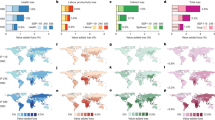
Global supply chains amplify economic costs of future extreme heat risk
Yida Sun, Shupeng Zhu, … Dabo Guan
Introduction
To curb climate change and reduce \(\hbox {CO}_{{2}}\) emissions, countries around the North Sea are looking towards offshore wind power. The North Sea has a high potential for offshore wind development, with favorable wind conditions, shallow waters, and proximity to large markets. However, offshore wind power also faces some challenges related to its variability and integration into the grid. While the accelerated deployment of large clustered wind farms undeniably contributes to reduced greenhouse gas emissions, it’s imperative to recognize that such deployments can also alter local climate conditions and potentially reduce future resource potentials 1 . Consequently, it is imperative that future climate change impact studies consider these alterations 2 . Nevertheless, it is noteworthy that the wind resources in northern Europe do not appear to be significantly impacted by climate change 3 . Other environmental impacts may also be included, as currently, the scientific literature lacks detailed studies regarding the ecological risks of offshore wind power 4 .
The North Sea is adjacent to several countries in Northern Europe, and each country’s Exclusive Economic Zone (EEZ) defines the available wind resources 5 . There are several initiatives underway to coordinate the development of offshore wind around the North Sea. For instance, the North Sea Energy Cooperation (NSEC) by the European Commission supports and facilitates the development of offshore grid development and the large potential for renewable energy in the region 6 . The group includes countries like the Netherlands, Belgium, Germany, Denmark, Norway, and Sweden. Another ongoing project is the North Sea Wind Power Hub (NSWPH) that aim to ensure that offshore wind development does not become fragmented, country by country, but transnational and coordinated 7 . A core concept is to build a large artificial island in the North Sea that would serve as a hub for connecting offshore wind farms in the region. The project was founded by Transmission System Operators (TSOs) from Denmark, Germany, and Netherlands.
In 2022, energy ministers from Denmark, Belgium, Netherlands, and Germany came up with a joint declaration for offshore wind in the North Sea with the goal of substituting fossil fuels with renewables from the North Sea 8 . In addition, the Norwegian government has stated plans to grant licenses for 30GW offshore wind by 2040 9 . United Kingdom (UK) has also targets for offshore wind developments, with an ambitious target of a fivefold increase to 50GW in 2030 10 . Nevertheless, ambitious plans for offshore installations in the North Sea were already established in 2016 11 . At the time of writing this paper, there were plans for over 500GW of installed offshore wind around the North Sea, which is the main offshore region for Northern Europe 1 .
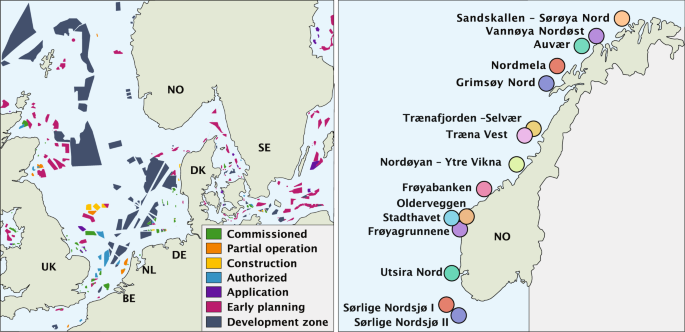
Map over the North Sea showing the status of the wind farms 12 and map over the areas the Norwegian water resources and energy directorate (NVE) has pointed out as potential offshore wind areas.
Norway’s efforts to harness offshore wind power are well underway, with an 88MW floating wind farm, Hywind Tampen, officially launched in 2023. It is the world’s first floating wind farm to power offshore oil and gas platforms, providing electricity for the Norwegian North Sea’s Snorre and Gullfaks oil and gas fields. The estimated investment cost of Hywind Tampen was $691 million or $7.9 million per MW, with the Norwegian authorities pledging up to $262 million via Enova subsidies. In addition, the Norwegian business sector’s NOx fund offered up to $64 million. The wind farm is expected to meet about 35% of the electricity demand of the two fields. This will cut CO 2 emissions from the fields by about 200,000 tonnes annually.
Nonetheless, as ambitious as these offshore wind development plans may be, they face significant challenges. Studies indicate that the wind power sectors in countries such as France, Germany, and Denmark will require continued subsidies to remain profitable 14 . Although costs associated with onshore and offshore wind power have declined over recent decades 15 , the downward trend ceased in 2020, with prices returning to 2015 levels by early 2023. Supply chain disruptions and rising energy and interest costs have been identified as potential factors influencing this shift 16 .
To understand the impact that larger shares of intermittent energy have on the grid, we may introduce the cannibalization effect and its influence on the capture price obtained by intermittent energy sources 17 . In essence, the cannibalization effect suggests decreasing power prices when a substantial amount of energy is supplied simultaneously. As a result, the capture price obtained by these power plants could be lower than that obtained by baseload power plants, which can operate continuously.
Reducing the correlation between various offshore wind farms can lessen the overall power variability across the entire fleet. Enhanced stability in power output, in turn, increases the chances of generating electricity during peak market prices, thus leading to a higher capture rate 18 . Consider, for instance, that strategic placement of these wind farms might lift the capture rate from 80 to 85%. For a hypothetical 30 GW Norwegian offshore wind power fleet, this difference is significant. With a 50% capacity factor and a baseload power price of $60/MWh, this 5% boost in the capture rate could result in $394 million in additional annual revenues, equivalent to $3/MWh. This scenario highlights the importance and potential financial benefits of smart placement and operation strategies.
In light of these considerations, this paper focuses on exploring the correlation challenges related to offshore wind power in the North Sea to evaluate the potential for increasing its value, with a focus on the Norwegian case. As shown in Fig. 1 , we discuss the deployment activities and plans for the North Sea and the nve locations considered for Norway. A summary of the offshore wind targets and their installed capacity by 2022 is provided in Table 1 . The considered nve locations for Norwegian offshore wind are described in Table 2 .
Existing research already acknowledge that several challenges associated with offshore wind energy need to be addressed. These challenges include extreme weather conditions like Dunkelflaute , which can result in prolonged reductions in wind power generation 20 . To tackle these power fluctuations, one proposed solution for countries like Poland involves the construction of smaller, geographically dispersed wind farms 21 . Additionally, research has delved into the intermittency of wind power and potential mitigation strategies, often examining hypothetical electricity grids. Findings indicate that connecting wind farms across larger geographic areas can help smooth out some of the variability in wind power generation 22 . Studies on North Sea offshore wind power variability have been conducted, specifically focusing on regions such as the UK 23 . Moreover, the concept of complementarity between wind and solar power has been suggested as a potential hybrid energy system solution to reduce seasonal variability, though its effectiveness varies depending on the temporal scale 24 , 25 . Another innovative approach involves co-locating offshore wind and wave power to mitigate variability in individual renewable energy sources 26 . The role of diurnal smoothing, influenced by spatial variations in wind speed timing, has also been explored 27 . Moreover, there are several proposals for producing hydrogen as an ancillary service to address offshore wind power variability and facilitate further expansion both from researchers 28 , 29 . Furthermore, a hybrid hydrogen-battery storage system has been presented as a promising solution 30 . Alternative approaches, such as demand flexibility measures, have been proposed in lieu of strategically distributing wind farms 31 . Another alternative is to expand firm, dispatchable generation capacities, such as hydropower 32 , although it’s important to note that the potential for this option is limited in many regions worldwide. This paper aims to contribute to the optimization of offshore wind farm placement by introducing a method to reduce overall correlation among buildouts, thus enhancing geographical smoothing. This paper focuses on a particular research gap that has been identified. A comprehensive analysis of the interactions between different sites within a country and its interactions with other North Sea producers is currently missing. We aim to fill that gap with a focused case study for Norway. The primary contributions of this paper include:
A correlation analysis of offshore wind power in Northern Europe; and,
A methodology to minimize the variance of a wind power fleet using the Augmented Lagrangian Algorithm (ALA), which has the benefit of obtaining the unique optimal solution to nonlinear, convex optimization problems.
We intend to demonstrate that a weighted combination of the proposed Norwegian offshore wind farm locations ensures the least intermittent power output. This approach is fundamentally different from focusing on building out in locations with the best resources and being less concerned about the variability. While this study primarily explores offshore wind buildout optimization in the Norwegian North Sea, related research has examined the consequences of the assumed buildouts 19 . Additionally, a recent work has investigated the potential for strategically distributing wind farms in Brazil to significantly mitigate seasonal variability in offshore wind power using a genetic algorithm (GA) 33 . Given the nonlinear and convex nature of our optimization problem, we have determined that our proposed ALA is a more suitable choice than GA. Some optimization strategies have focused on enhancing individual wind farm performance or optimizing annual energy output 34 . Recent efforts have also concentrated on refining the methodology for estimating and validating wind resources and variability in the North Sea and Northern Europe 35 , 36 . Marine spatial planning (MSP) represents another avenue for coordinating offshore wind buildouts with other marine activities, thereby maximizing synergies with offshore energy generation 37 .
The rest of the paper is structured as follows: the ’ Methodology and assumptions ’ section details the proposed methodology to minimize the variance of a wind power fleet and describes the data collection process. The ’ Results and discussion ’ section presents and discusses our findings, and finally, the ’ Conclusions ’ section summarises the study’s key insights.
Methodology and assumptions
This section focuses on the methodological approach undertaken in this study. It first introduces a proposed algorithm designed to minimize the variance of a wind power fleet’s power outputs. This addresses the challenge of correlation, a major factor in the variability of wind power generation. The algorithm’s design allows it to handle and balance power outputs from various wind farms. Finally, a description of the dataset and case studies used to apply and test the efficacy of this algorithm is provided.
Optimization algorithm
In order to solve the correlation problem, the idea is to leverage power outputs to reduce variance and boost the system-level capacity factor rather than maximizing overall energy output. To minimize the variance of the sum of the weighted power outputs from the different farms, the weights need to be defined in an optimization variable (vector) \(\textbf{x}\in {\mathbb {R}}^{N}_{+}\) , where
We define the matrix, \(\textbf{Y} \in {\mathbb {R}}^{N\times T}\) in Eq. ( 2 ), where a row represents power output for an offshore wind farm \(i\in {\mathbb {R}}^{N}\) over each time step in the time horizon \(t\in {\mathbb {R}}^{T}\) .
To leverage the opportunity to either minimize the variance or maximize the capacity factor, the objection function to be minimized is defined as,
where \(\alpha \in [0,1]\) is a predetermined parameter. The problem is constrained such that the sum of the weights equals one, \(\sum ^N_i x_i = 1\) , and weights have to be non-negative, \(x\ge 0\) . By setting \(\alpha =0\) and solving, i.e. minimizing only the variance of the weighted sum of some variables, we get a result that reduces both the variance of the variables and the covariance between them. As seen from the definition of variance between two variables a and b ; \(\textrm{Var}(a+b)=\textrm{Var}(a) + \textrm{Var}(b) + 2\textrm{Cov}(a,b)\) . To simplify our problem, we reformulate our problem in the following general form
Our problem Eq. ( 4 ) is a nonlinear convex optimization problem. To solve it, we apply the Augmented Lagrangian optimization algorithm 38 , a widely used method for solving constrained optimization problems. Since the problem has a convex objective function and constraints, the algorithm will converge to a globally optimal solution, given that its penalty parameter \(\rho\) is chosen appropriately. The Augmented Lagrangian of Eq. ( 4 ) is defined as
where \(\lambda\) and \(\mu\) are the Langrangian multipliers associated with Eqs. ( 4b ) and ( 4c ), respectively. The identity matrix \(I_{\rho }\) has zero valued diagonal elements for index i if \(h_i(\textbf{x})<0\) and \(\mu _i=0\) , else the diagonal values are \(\rho\) . The algorithm for solving the Augmented Lagrangian problem is given by Algorithm 1 (The code for the project can be found at: https://github.com/martinhjel/wind-covariation ).
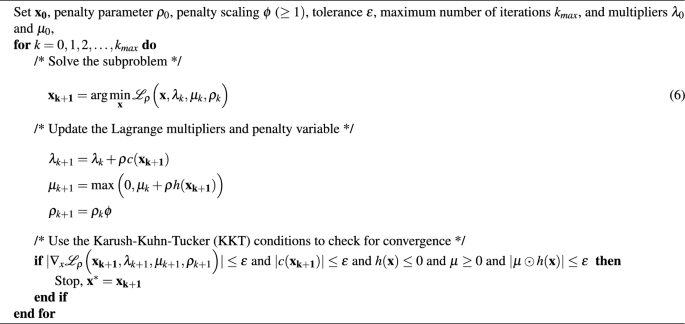
Augmented Lagrangian Algorithm.
By constructing and applying the Augmented Lagrangian optimization algorithm, we are setting the groundwork for a practical solution to the problem of power intermittency in offshore wind farms. Thus, the optimization algorithm is an instrumental tool in this research, providing a practical, mathematical framework to minimize the variance of a wind power fleet, leveraged with its capacity factor.

Methodological flowchart outlining the main steps taken in this study.
Data collection
In this study, we rely on data collected from renewable.ninja 39 that is based on NASA’s Modern-Era Retrospective analysis for Research and Applications (MERRA) 40 . MERRA is a reanalysis product that provides a consistent, long-term record of global weather patterns, which makes it a valuable tool for assessing wind resources. MERRA uses an advanced data assimilation system to integrate various observational data, including satellite measurements, into a global weather model, resulting in a comprehensive dataset of wind speed and direction, among other meteorological variables, at multiple altitudes and time intervals. The data has a spatial resolution of 0.5 degrees, hourly time resolution, and spans from 1979 to present time. The data provided by renewable.ninja and used in this work, spans from 2000 to 2019.
Despite the strengths of MERRA, like any reanalysis product, it is not without its limitations. To address these and enhance the accuracy of the wind resource estimates, renewable.ninja apply national correction factors. These factors adjust for systematic biases in the MERRA data and help align it more closely with nationally observed wind conditions, yielding an \(\hbox {R}^2\) value above 0.95 41 . The hourly power production is calculated via Renewable Ninja’s virtual wind farm (VWF) model 42 , based on hourly wind speed and temperature data from NASA’s MERRA and MERRA-2 reanalysis, which has been validated for the UK 43 , 44 . Furthermore, the VWF was evaluated against actual power outputs from the Smøla (150MW) onshore wind farm in Norway (with Gaussian filtering) and for the Hywind demo (2.3MW) offshore flowing wind turbine in the Norwegian North Sea (without any Gaussian filtering) 19 . While there may be some uncertainty in the mean power output (i.e. capacity factors), it is still deemed that the production variability from hour to hour is well represented.
As highlighted in step 1 in Fig. 2 , the VWF collects wind speeds at 2, 10, and 50 meters above ground at each spatial position of the MERRA grid dataset. Extrapolation of the wind speed at the turbine’s height above sea level (100 meters) is based on the logarithmic profile law. Working out the exact wind speed from reanalysis data for a specific turbine height is computationally expensive. Finally, the VWF model converts estimated wind speeds to power outputs using a real-world wind turbine power curve (i.e. Vestas V80/2000), which are aggregated to represent a complete wind farm better. This is done using a Gaussian filter with standard deviation ( \(\sigma = 0.2\) ) for the single wind turbine power curve. Assuming one specific power profile is a limitation, as there is a possibility to derate or redesign the turbine, at some higher cost, to produce relatively more at lower wind speeds. However, we assume in this study that the most cost-effective wind turbines will be prioritized offshore. Since wind turbine power curves exhibit relatively uniform characteristics, the specific selection of a power curve holds limited significance within the scope of the current study.
When compared with other reanalysis datasets, such as the European Centre for Medium-Range Weather Forecasts (ECMWF) Re-Analysis (ERA5) or the National Centers for Environmental Prediction (NCEP) North American Regional Reanalysis (NARR), MERRA exhibits some beneficial features. For one, it is widely recognized for its high temporal resolution and its accuracy in complex terrain and coastal regions, making it particularly suitable for offshore wind resource assessment. However, it should also be noted that the accuracy of reanalysis products can vary depending on the geographical region and the specific weather variables of interest.
A study compared the performance of the fifth generation of the European Centre for Medium-Range Weather Forecasts Reanalysis (ERA5) reanalysis and the Modern-Era Retrospective analysis for Research and Applications, version 2 (MERRA-2) reanalysis in modeling wind power generation for five different countries and 1051 individual wind turbines in Sweden 45 . The results showed that ERA5 performs better than MERRA-2 in all analyzed aspects, with correlations higher and errors lower. This finding could indicate that the quality of the data used in this study could be improved by using multiple datasets and cross-validation for a comprehensive and reliable wind resource assessment. This is, however, deemed out of the scope of this study, and we encourage research on this to open source their datasets to aid future research.
The MERRA-2 dataset has been utilized in studying offshore wind over a 30-year period in various locations 46 . Other datasets include the NORA3-WP dataset, which encompasses the Baltic, North, Norwegian, and Barents Seas 47 . The NVE provides an alternative dataset 48 , which is influenced by work from 49 , 50 and contains historical data for offshore wind regions pertinent to this study. However, for ease of modeling and data uniformity, this study solely utilizes the renewable ninja data.
Previous studies using NVE data have provided insightful findings. A 2020 report from NVE 51 revealed that in years with low hydro inflow, temperatures are also cold and lower wind power outputs are observed. Norway, with its varying wind conditions between the north and south regions, experiences the highest wind power output during winter. Unfortunately, in the coldest winter days with the highest demand wind resources are scarce. The report also underlines the grid balancing challenges posed by rapid fluctuations in power outputs from wind and solar sources.
The data is collected by computing the centroids of the proposed Norwegian wind farms, and some selected regions from the other North Sea countries (see Fig. 10 a) and querying the renewable ninja API.
Results and discussion
This section presents and interprets the results of our study, which primarily leveraged data obtained from renewable.ninja. Through a careful assessment of these data, we were able to extract meaningful insights into offshore wind resource potential and variability. The data has been meticulously analyzed to produce a comprehensive set of findings, revealing significant patterns and trends. These findings not only contribute to our understanding of wind power potential but also shed light on the intricacies of wind behavior under varying geographical conditions.
In the following subsections, we present our results and discuss these findings. The objective is not just to present the raw data but to provide context and interpret the implications. We also discuss the strengths and limitations of our approach, providing an opportunity for further research to build upon our work.
While our findings do not encompass every potentiality due to the data and scope limitations, they form a strong basis for future research in this field and contribute valuable insights for stakeholders involved in wind power development.
The section is divided into two. The first part investigates the wind power data and correlation factors. Finally, the second part shows the result of the optimization algorithm for optimally sizing the different wind farms.
Analysis of wind power data
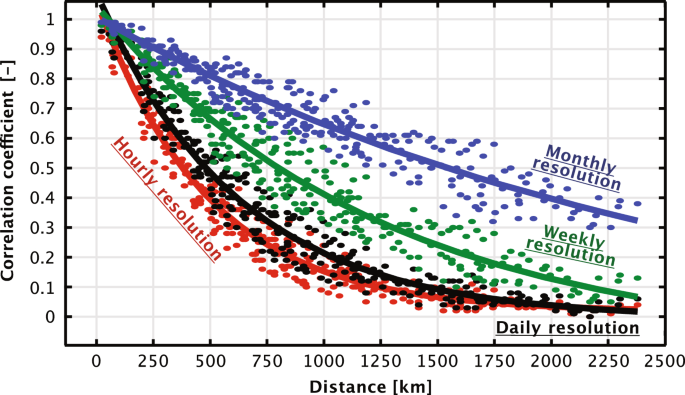
Scatter plot of correlation coefficients ( r ) between different wind farms with respect to distance and exponential curve fit of the data points. Results include hourly (1h), daily (24h), weekly (168h), and monthly (720h) time resolutions.
The correlation coefficients between various wind farms around the North Sea have been gathered and graphically represented against the distance in Fig. 3 and compared with exponential curve fit functions described in Table 3 . Exponential curve fits, corresponding to various resolutions including hourly (1h), daily (24h), weekly (168h), and monthly (720h), indicate that correlation diminishes as the distance between wind farms increases. It’s noteworthy that correlation coefficients drop below 0.5 at distances exceeding 384km at an hourly resolution and 808km at a weekly resolution. Higher time resolutions inherently smooth short-term fluctuations, thereby increasing correlation. However, during longer periods of wind drought, such as the one experienced in Europe in 2021 , the geographical dispersion of wind power farms becomes less effective, emphasizing the need for backup capacity and storage for longer durations.
The majority of correlation coefficients are positive, implying that negative correlation, which would be advantageous for risk diversification, is rare. Nevertheless, geographical dispersion of wind farms over long distances can significantly smoothen wind power output, but this effectiveness decreases over extended time periods. Given that the North Sea spans approximately 580 km in width and 960 km in length, wind farms established by individual countries will inevitably impact others. Thus, a coordinated approach toward the development of North Sea wind farms is vital for minimizing the overall variability of the region’s wind farm fleet.
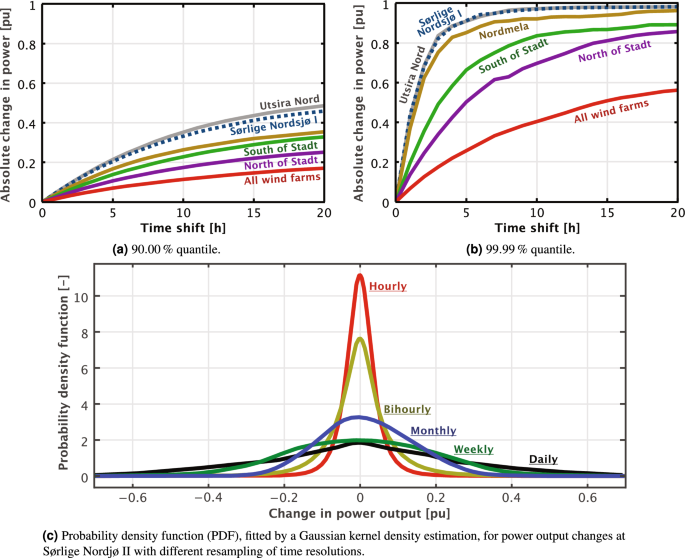
Changes in wind power output as a function of time with evenly distributed weights ( \(x_1\) , \(x_2\) , ..., \(x_{15}\) \(=\) 6.67%).
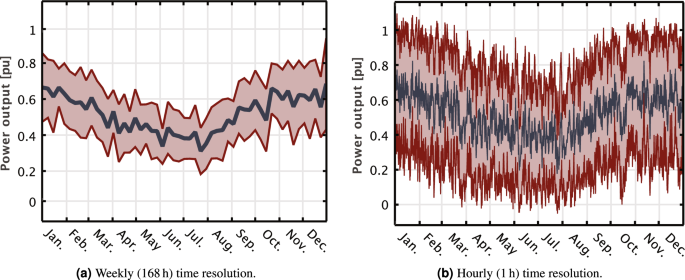
The yearly mean and standard deviation of wind power in the area of Utsira Nord for the years 2000 to 2019.
Malvaldi et. al. 52 have already highlighted the decrease in correlation between wind farms with distance. They emphasized the need for prioritizing interconnections between EU countries to maximize wind power production and effectively manage its variability. This is further corroborated by Fig. 4 , which reveals that the collective output from proposed Norwegian offshore wind farms exhibits far less variability than individual parks. Observe in Fig. 4 a how, for the entire wind power fleet, it takes more than 20 hours for the absolute change to be more than 20% for 10% of the time (i.e. 90% quantile), while for 0.01% of the time (i.e. 99.99% quantile), in Fig. 4 b, this change happens in just 4 hours. The probability for changes in power outputs for a single wind farm is shown in Fig. 4 c, in which we can observe significant differences in behavior for different time scales.
Time resolution plays a pivotal role in evaluating the variability of wind power output, as illustrated in Fig. 4 c. Higher variability in wind power output is evident at daily and weekly time resolutions, highlighting the necessity for backup capacity and energy during these periods. This may explain the rise of gas-fired power plants in Europe, as they are capable of fulfilling this role. Other researchers have also observed a need for increased backup energy and storage in wind-dominated power systems 53 . The successful integration of renewable energy, particularly wind power, has historically relied on the presence of fossil-based backup capacity 54 . However, reliance on coal power would lead to increased heat rates and, subsequently, increased fuel consumption, reducing the carbon mitigation effect by 13% 55 . Similar effects are also true for fast-acting single-cycle gas turbines compared to the more efficient but slow-acting, closed-cycle gas turbines. These findings underscore the importance of adopting a system-wide perspective for power system developments with regard to reducing CO 2 emissions.
Figure 5 shows the variability of wind power from Utsira Nord for weekly and hourly time resolutions between different years. While variability is smoothed out over longer periods, Fig. 5 b reveals significant standard deviation at the hourly resolution, emphasizing the need to combine outputs of several wind farms across a large geographical region. Furthermore, despite apparent seasonal trends that match well with the Norwegian demand profile, the availability of wind power cannot be guaranteed over shorter time scales, as the changes from hour to hour can be substantial.
In Fig. 6 , the wind power correlation relationships between the different wind power aggregated areas and locations are presented in matrix form, respectively. In the region of Stadt in Norway (the areas Stadthavet, Olderveggen, Frøyagrunnene), one can observe a drop in the correlation between the areas north and south. For instance, the correlation ( r ) from Sørlige Nordsjø II drops from 0.7 to 0.41 from Utsira Nord to Frøyagrunnene, and further to 0.19 to Frøyabanken. From these results, one could argue that in order to reduce the correlation with the rest of the North Sea countries and reduce the variance of the combined wind power fleet, Norway should focus on building out the northernmost areas. This hypothesis will be further evaluated when presenting the optimization results in the following subsections.
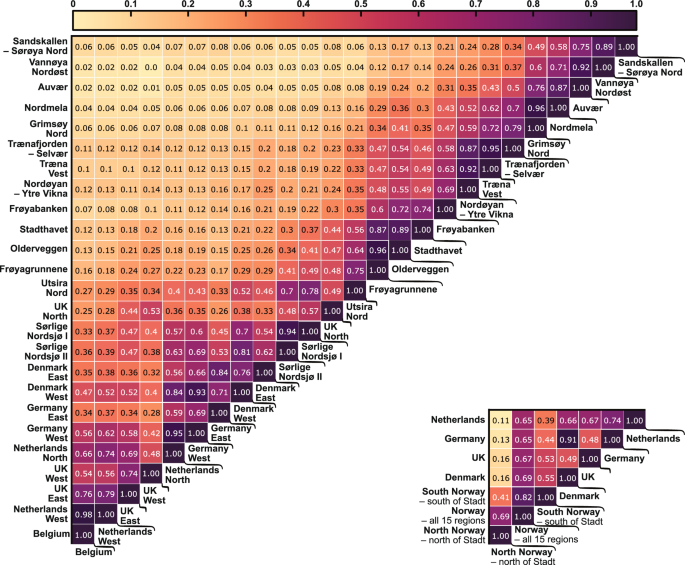
Upper left: Standard correlation coefficient matrix for all the studied regions. Bottom right: Standard correlation coefficient matrix for some aggregated areas. Coefficients calculated with a daily (24h) time resolution.
Further evidence illustrating how distance affects correlation is presented in Fig. 7 a. The figure illustrates the bivariate distribution between Nordmela, a northern wind farm, and Sørlige Nordsjø II, the southernmost wind farm in Norway. It can be noted that when Nordmela has low power output, there’s a higher probability of Sørlige Nordsjø II displaying high power output.
In contrast, the bivariate distribution between Sørlige Nordsjø II and Germany West, as depicted in Fig. 7 b, exhibits a more close connection. Notable observations include a significant peak distribution at high outputs for both farms and a smaller peak at low outputs. Evidently, the correlation between the southernmost Norwegian offshore wind farm, Sørlige Nordsjø II, and European regions, specifically Germany West, is substantial.
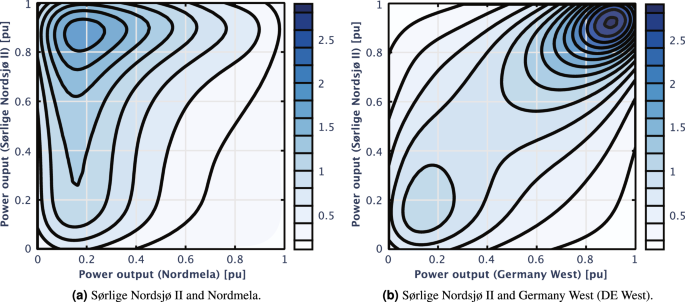
Bivariate distribution of wind power output by heatmaps generated using Gaussian kernel density estimation.
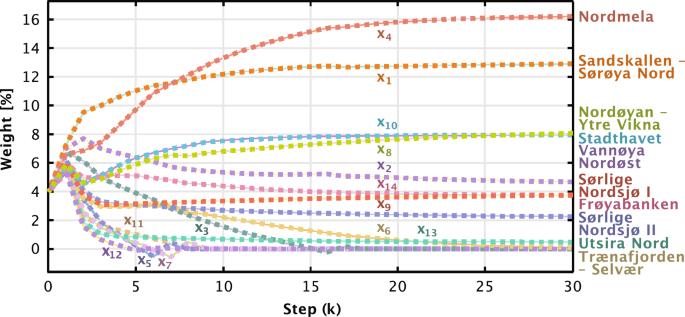
Trajectory of the learning of the weights for Norwegian offshore wind farms with hourly (1h) resolution, when the weights of the European offshore wind farms, \(x_{16}\) to \(x_{25}\) , are fixed to 4%, and \(\alpha = 0\) .
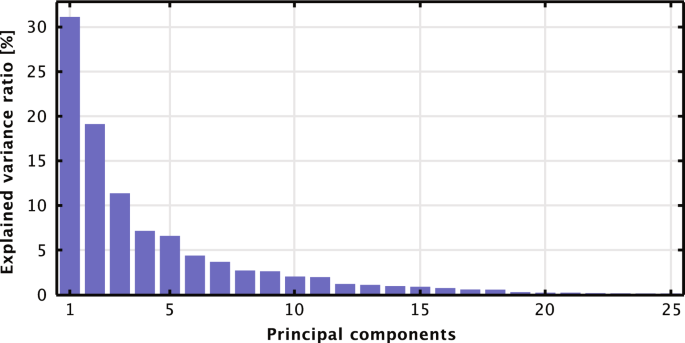
Principal component analysis (PCA) of the 25 studied regions.
To further examine the correlation patterns of the North Sea wind power data, we initiated a quantitative assessment of the dataset’s suitability for Principal Component Analysis (PCA) via the Kaiser-Meyer-Olkin (KMO) measure of sampling adequacy. A KMO value of 0.81 was determined, which denotes that a significant proportion of the variance in our variables is shared. From the PCA analysis in Fig. 9 , we observed that out of 25 derived principal components, the predominant two jointly explained 50.3% of the variance in the dataset. The extensive variance elucidated by the primary two components accentuates the mutual patterns and correlations across the studied regions, providing a statistical underpinning to the visual and qualitative analyses.
It’s important to note that these findings are based on a model using a fixed turbine type. However, utilizing alternative turbine types, where lower energy output could be compensated with higher capacity factors, and thus more stable wind power conditions, may introduce a smoothing effect. This effect could in turn modify the correlation coefficients and decrease the variability of the wind power output. Evaluating these potential differences, though, is considered beyond the scope of the present study.
Optimal weighting of offshore wind farms
This section employs the Augmented Lagrangian Algorithm to identify the minimum of the objective function defined in Eq. ( 3 ). Initially, the European offshore wind farm regions are each assigned a weight of 4%, implying that European sites account for 40% of the relative power system interacting with Norway. The algorithm commences with equal weights of 4% for all variables, as depicted in Fig. 8 , and generally converges after several iterations. The rate of convergence is sensitive to the numerical tolerance accorded to the Karush-Kuhn-Tucker (KKT) conditions. For simplicity, we present only the first 30 steps.
Table 4 shows the converged values obtained in the learning process, alongside optimized values for scenarios with varying emphases on overall power output relative to the minimization of variance. Scenarios include those with \(\alpha = 0.1\) , \(\alpha = 0.3\) , and \(\alpha = 0.5\) - the last of which equally weights overall power output and variance reduction. In this particular case, the Norwegian offshore wind power expansions occur solely in Stadthavet and Sørlige Nordsjø II, with the latter being highly weighted to deliver increased power output.
With the optimized weights in Table 5 , the proportions of the European offshore wind farm regions can also be optimized. Notably, if we aim only to minimize variance, Denmark West, Germany West, Netherlands North, and Netherlands West will not see any buildouts. However, if overall power output becomes more significant, Germany West and Netherlands North play a larger role in the energy mix.
Table 6 showcases optimized results for Norwegian offshore wind buildouts without considering European interaction. Here, if the objective is to minimize variance, less than a third of the buildouts will occur in southern Norway. Table 6 also shows that the assumed buildouts account for the majority in the South, yielding a higher overall variance. These results are in line with another study, where we have included their weightings of the wind farms in the table 19 . Figure 10 presents a map of relative buildouts considering and disregarding European interconnections.
Tables 4 , 5 , and 6 collectively indicate a tradeoff between maximizing wind power output and reducing correlation. This implies a need for strategic objective weighting, particularly when the ambition to diminish correlation competes with reducing the levelized cost of electricity (LCOE). Higher correlation can indeed lead to power price cannibalism, thereby diminishing revenues for the wind farms 18 .
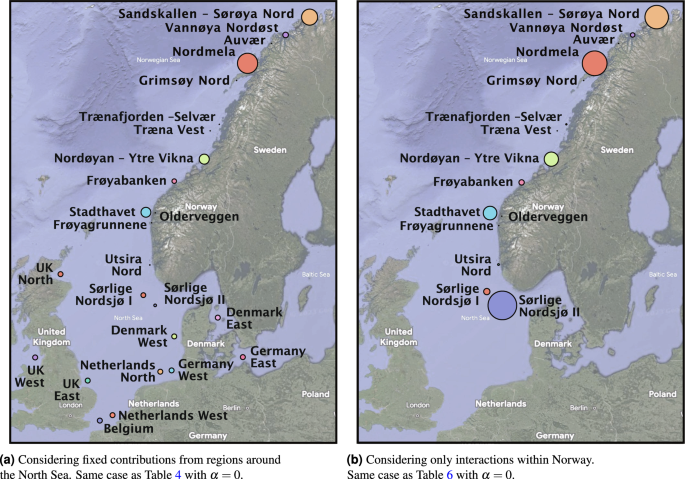
The scale of the dots for each area represents how offshore wind power should be built out to reduce the variance of the wind power fleet as a whole with hourly (1h) resolution. Note how the model gives little weight to the Norwegian offshore wind farms in the south (especially Sørlige Nordsjø II) when including wind farms for all countries around the North Sea.
Our optimization results indicate that prioritizing the development of the wind resource areas farthest away is key to reducing wind power variance around the North Sea. As there is a lot of activity on the European continental side of the North Sea 8 , it would be desirable to find ways to reduce the overall wind power correlation. Building a significant portion of Norwegian offshore wind capacity in the northern regions of Norway aligns with our optimization model, especially in terms of reduced correlation. However, this poses a dilemma, as these remote locations are also the costliest to develop. In a scenario where one accepts a higher wind power correlation, there will be more sporadic energy scarcity and abundance, and more of the aforementioned backup capacity will be required. However, suppose one aims to deal with the correlation problem with extensive energy storage solutions like battery storage. Here, predictions indicate that by 2031, Europe will only be capable of storing about 10 minutes of its electricity in batteries (i.e. 89GWh) 56 , which takes into account a twenty-fold increase from today’s levels. Nevertheless, Norwegian hydropower, with about half of Europe’s storage capacity (i.e. 87TWh) 32 , can play a role. However, the hydropower fleet’s dispatchable power capacity is limited to just 30GW. This underlines the importance of other flexible non-polluting actors in the energy system. Construction of a diverse power infrastructure could be beneficial to mitigate potential energy scarcity in Europe, considering other non-polluting energy sources like nuclear energy, as demonstrated by the Polish nuclear program 57 .
Nevertheless, there are several possible solutions to address the correlation challenges for wind power in the North Sea. First of all, the development in the region should be done in cooperation with all member countries, as compared to the current situation where only some countries have found together. Cooperation could harmonize energy policies, regulations, and standardization. Best practices could be shared for all countries to avoid common pitfalls. Local bottlenecks can be alleviated by increasing the interconnection capacity and ensuring that countries around the North Sea are coupled more tightly together. This has the benefit of utilizing the smoothing effect observed by wind power over larger distances, as seen in Fig. 3 . The downside, however, is that countries may give away some of their security of supply as it, without any additional investments in local backup capacity such as gas-fired power plants, more often rely on the energy coming from elsewhere.
Closer power grid coupling could also enable better sharing of energy storage solutions and demand-side responses. However, countries with significant energy storage, like Norway with its hydro reservoirs, may experience increased variability due to interconnected energy availability. This increased variability could result in hydro reservoirs being operated less flexibly as the future energy availability becomes more uncertain. As a consequence, operators may be more inclined to maintain their reservoir levels at the midpoint.
Another method to deal with the correlation challenges is to improve forecasting, reduce the uncertainty and variability in supply and demand, and enable better scheduling of generation and transmission capacities. Sharing of data between wind farms would be beneficial but perhaps hard to achieve in a competitive market environment. Forecasting wind power is, however, a challenging task for periods longer than a couple of days and not useful after almost one week 58 , so this would only aid in the shorter term.
The reduction in correlation between offshore wind farms can be advantageous as it potentially lessens the variation of the total power output. However, such an approach may lead to more dispersed build-outs, thereby escalating the construction costs and necessitating extended transmission grids.
Our study illustrates that while expanding the Northern offshore wind farms would indeed lead to decreased correlation, it might not be economically feasible. This claim is backed by the historical costs of transmission grids in Norway, which stand at approximately $1.2 million per km per GW 59 . Considering Norway’s length of 1748km, the cost of a transmission line across the country would approximate $2100 million per GW transmission. This cost has to be contrasted with the potential increase in the capture rate, which could result in savings annually of $394 million, by 5% increase capture rate, as explained in the introduction. The net present value of such a hypothetical improvement is $4600 million, assuming an economic lifetime of 25 years and a discount rate of 7%. Clearly, the financial viability of such a project needs to be studied in further detail. In addition, the LCOE costs associated with not building out wind power in the areas with the best resources but selecting regions to reduce the overall correlation would also be necessary to take into account. This assertion calls for more detailed studies to draw more definitive conclusions.
Conclusions
This paper presents a comprehensive mapping of the optimal composition of wind farms in the Norwegian North Sea, with a primary focus on minimizing correlation challenges and reducing grid integration costs. One of the scenarios in our research is the projected expansion of interconnections among EU countries, which would allow for the smoothing of wind power generation. Given this scenario, it becomes preferable to construct the majority of offshore wind farm capacity in northern Norway. This preference is further emphasized in the mapping of wind power correlation coefficients between Norwegian and European offshore wind sites. Notably, we found that northernmost sites exhibit a significant decrease in correlation with Europe, mainly due to their geographical distance. In the alternative scenario explored, offshore wind expansion occurs independently of any coordination with interconnections. This results in a notably distinct development pattern, with a substantial concentration of wind farm installations in southern Norway. It is crucial to underscore that this approach leads to a greater variability in wind power output, as it lacks the geographical smoothing effect achieved through collaboration with neighboring countries in the North Sea. In summary, our research underscores the importance of geographical smoothing, a concept with potential relevance for numerous countries in the North Sea region and beyond.
While the winter season shows a trend of increased wind power resources, our analysis at an hourly resolution indicates a considerable standard deviation in wind power output over 20 years of collected data. Nevertheless, we observe a smoothing effect when considering a collective of wind farms, as it can diminish the absolute change in power output.
The present paper has certain limitations, including the utilization of publicly available MERRA2 weather reanalysis data for numerical analysis. Wind speeds were estimated vertically using extrapolation grounded in the logarithmic profile law. Additionally, the power output, as influenced by wind speed, was determined based on the characteristics of a specific wind turbine type, and Gaussian filtering was applied to account for the geographical dispersion of wind farms, which is a simplified approach. Nonetheless, it is important to note that earlier studies have demonstrated that the paper’s primary focus, which is variations and correlations in wind power output, is adequately captured 19 . Nevertheless, when it comes to modeling wind resources, particularly mean power output, it is acknowledged that this approach may not be as precise when compared to real-world data.
For future research, we suggest utilizing multiple datasets (including ERA5) and performing cross-validation studies to enhance the reliability of wind resource assessments. This approach would expand beyond the scope of this paper, which primarily focuses on capturing wind resource variability. There should also be an investigation into how consumption patterns in different regions around the North Sea could influence the optimal sizing of wind farms, taking into account a detailed energy system model that balances the value of a more dispersed wind farm fleet against additional transmission, construction, and maintenance costs.
Furthermore, exploring the utilization of various turbine types to maximize energy outputs while reducing the variability of the combined wind power fleet would provide valuable insights for decision-makers involved in the ongoing development of offshore wind power in the North Sea region. This research could ultimately contribute to more efficient and sustainable energy strategies, promoting the successful integration of renewable energy sources into the grid.
Data availability
This paper relies primarily on leveraged data obtained from the renewable.ninja 39 environment, which is based on NASA’s MERRA 40 . Derived raw data supporting the findings of this study are available from the corresponding author J.K.N. upon reasonable request.
Akhtar, N., Geyer, B., Rockel, B., Sommer, P. S. & Schrum, C. Accelerating deployment of offshore wind energy alter wind climate and reduce future power generation potentials. Sci. Rep. 11 , 1–12 (2021).
Google Scholar
Akhtar, N., Geyer, B. & Schrum, C. Impacts of accelerating deployment of offshore windfarms on near-surface climate. Sci. Rep. 12 , 18307 (2022).
Article ADS CAS PubMed PubMed Central Google Scholar
Hahmann, A. N., García-Santiago, O. & Peña, A. Current and future wind energy resources in the North Sea according to CMIP6. Wind Energy Sci. 7 , 2373–2391 (2022).
Article ADS Google Scholar
Galparsoro, I. et al. Reviewing the ecological impacts of offshore wind farms. NPJ Ocean Sustain. 1 , 1 (2022).
Article Google Scholar
Nøland, J. K., Auxepaules, J., Rousset, A., Perney, B. & Falletti, G. Spatial energy density of large-scale electricity generation from power sources worldwide. Sci. Rep. 12 , 21280 (2022).
Article ADS PubMed PubMed Central Google Scholar
European Commission. The North Seas Energy Cooperation. https://energy.ec.europa.eu/topics/infrastructure/high-level-groups/north-seas-energy-cooperation_en .
The North Sea Wind Power Hub Programme. Hubs and spokes - viable beyond theory . Tech. Rep. https://northseawindpowerhub.eu/files/media/document/NSWPH_Hubs%20and%20spokes%20%E2%80%93%20viable%20beyond%20theory_nov.%202022_1.pdf (2022).
Jørgensen, D., Van der Straeten, T., Jetten, R. & Habeck, R. The declaration of energy ministers on the north sea as a green power plant of Europe. https://windeurope.org/wp-content/uploads/files/policy/position-papers/20220518-Declaration-of-energy-ministers.pdf (2022).
Norwegian government. Ambitious offshore wind initiative. https://www.regjeringen.no/en/aktuelt/ambitious-offshore-wind-power-initiative/id2912297/ (2022).
Stuart, G. UK signs agreement on offshore renewable energy cooperation. https://www.gov.uk/government/news/uk-signs-agreement-on-offshore-renewable-energy-cooperation (2022).
Schiermeier, Q. Europe leads growing market in offshore wind power. Nature. https://doi.org/10.1038/nature.2016.20454 (2016).
Article PubMed Google Scholar
4C Offshore. Global offshore wind farm map. https://map.4coffshore.com/offshorewind/ .
Global Wind Energy Council (GWEC). Global offshore wind report 2022. Tech. Rep. https://gwec.net/wp-content/uploads/2022/06/GWEC-Global-Offshore-Wind-Report-2022.pdf (2022).
Alonzo, B., Concettini, S., Creti, A., Drobinski, P. & Tankov, P. Profitability and revenue uncertainty of wind farms in Western Europe in present and future climate. Energies 15 , 6446 (2022).
Jansen, M. et al. Offshore wind competitiveness in mature markets without subsidy. Nat. Energy 5 , 614–622 (2020).
Goehring, L. R. & Rozencwajg, A. A. The distortions of cheap energy. Technical Report . https://f.hubspotusercontent40.net/hubfs/4043042/Content%20Offers/2021.Q4%20Commentary/2021.Q4%20GR%20Market%20Commentary.pdf (2022).
Blume-Werry, E., Huber, C., Resch, G., Haas, R. & Everts, M. Value factors, capture prices and Cannibalism: Nightmares for renewable energy decision-makers. J. World Energy Law Bus. 14 , 231–247 (2021).
Hirth, L. The market value of variable renewables. The effect of solar wind power variability on their relative price. Energy Econ. 38 , 218–236 (2013).
Svendsen, H. G. & Tande, J. O. 30 GW offshore wind in Norway: Time series analysis based on numerical weather model dataset. SINTEF Energy Research (FME NorthWind & Green Platform Ocean Grid projects) . https://sintef.brage.unit.no/sintef-xmlui/bitstream/handle/11250/3054972/Norway_30_GW_wind_v1_signed.pdf (2023).
Li, B., Basu, S., Watson, S. J. & Russchenberg, H. W. A brief climatology of Dunkelflaute events over and surrounding the north and Baltic sea areas. Energies 14 , 6508 (2021).
Kryzia, D. et al. Dampening variations in wind power generation through geographical diversification. IOP Conf. Ser. Earth Environ. Sci. 214 , 012038 (2019).
Solbrekke, I. M., Kvamstø, N. G. & Sorteberg, A. Mitigation of offshore wind power intermittency by interconnection of production sites. Wind Energy Sci. 5 , 1663–1678 (2020).
Potisomporn, P. & Vogel, C. R. Spatial and temporal variability characteristics of offshore wind energy in the United Kingdom. Wind Energy 25 , 537–552 (2022).
Schindler, D., Behr, H. D. & Jung, C. On the spatiotemporal variability and potential of complementarity of wind and solar resources. Energy Convers. Manag. 218 , 113016 (2020).
Magaña-González, R. C., Rodriguez-Hernandez, O. & Canul-Reyes, D. A. Analysis of seasonal variability and complementarity of wind and solar resources in Mexico. Sustain. Energy Technol. Assess. 60 , 103456 (2023).
Gaughan, E. & Fitzgerald, B. An assessment of the potential for co-located offshore wind and wave farms in Ireland. Energy 200 , 117526 (2020).
Gangopadhyay, A., Seshadri, A. K. & Toumi, R. Beneficial role of diurnal smoothing for grid integration of wind power. Environ. Res. Lett. 18 , 014022 (2023).
Scolaro, M. & Kittner, N. Optimizing hybrid offshore wind farms for cost-competitive hydrogen production in Germany. Int. J. Hydrog. Energy 47 , 6478–6493 (2022).
Article CAS Google Scholar
Durakovic, G., del Granado, P. C. & Tomasgard, A. Powering Europe with North Sea offshore wind: The impact of hydrogen investments on grid infrastructure and power prices. Energy 263 , 125654 (2023).
Ma, Z. et al. Rapid sizing of a hydrogen-battery storage for an offshore wind farm using convex programming. Int. J. Hydrog. Energy. https://doi.org/10.1016/j.ijhydene.2023.03.037 (2023).
Vrana, T. K. et al. Improving wind power market value with various aspects of diversification. Proc. Int. Conf. Eur. Energy Mark. (EEM). https://doi.org/10.1109/EEM58374.2023.10161990 (2023).
Øyvang, T. & Nøland, J. K. Superflexible hydropower for the Nordic grid: Accelerating the energy transition. IEEE Power Energy Mag. 20 , 66–78 (2022).
Fernandes, I., Pimenta, F. M., Saavedra, O. R. & Assireu, A. T. Exploring the complementarity of offshore wind sites to reduce the seasonal variability of generation. Energies 15 , 7182 (2022).
Xu, X. et al. A case study of offshore wind turbine positioning optimization methodology using a novel multi-stage approach. Front. Mar. Sci. 9 , 1028732 (2022).
Solbrekke, I. M., Sorteberg, A. & Haakenstad, H. The 3 km Norwegian reanalysis (NORA3)-a validation of offshore wind resources in the North Sea and the Norwegian Sea. Wind Energy Sci. 6 , 1501–1519 (2021).
Luzia, G., Hahmann, A. N. & Koivisto, M. J. Evaluating the mesoscale spatio-temporal variability in simulated wind speed time series over northern Europe. Wind Energy Sci. 7 , 2255–2270 (2022).
Spijkerboer, R., Zuidema, C., Busscher, T. & Arts, J. The performance of marine spatial planning in coordinating offshore wind energy with other sea-uses: The case of the Dutch North Sea. Mar. Policy 115 , 103860 (2020).
Fortin, M. & Glowinski, R. Augmented Lagrangian methods: Applications to the numerical solution of boundary-value problems. Stud. Math. Appl. 15 (Elsevier, 1983).
Pfenninger, S. & Staffell, I. Renewables Ninja. https://www.renewables.ninja (2022).
Rienecker, M. M. et al. MERRA: NASA’s modern-era retrospective analysis for research and applications. J. Clim. 24 , 3624–3648 (2011).
Staffell, I. & Pfenninger, S. Using bias-corrected reanalysis to simulate current and future wind power output. Energy 114 , 1224–1239 (2016).
Staffell, I. & Green, R. How does wind farm performance decline with age?. Renew. Energy 66 , 775–786 (2014).
Staffell, I. Developing an Open-Access Wind Profile for Great Britain Vol. 102510251025 (Department Energy & Climate Change, 2014).
Staffell, I. & Green, R. Is there still merit in the merit order stack? The impact of dynamic constraints on optimal plant mix. IEEE Trans. Power Syst. 31 , 43–53 (2016).
Olauson, J. ERA5: The new champion of wind power modelling?. Renew. Energy 126 , 322–331 (2018).
Kim, B., Lee, K., Ko, K. & Choi, J. Offshore wind resource assessment off the coast of Daejeong, Jeju island using 30-year wind estimates. Sci. Rep. 12 , 14179 (2022).
Solbrekke, I. M. & Sorteberg, A. NORA3-WP: A high-resolution offshore wind power dataset for the Baltic, north, Norwegian, and Barents seas. Sci. Data 9 , 362 (2022).
Article PubMed PubMed Central Google Scholar
Skaansar, E. et al. Weather datasets for the power system models (Værdatasett for kraftsystemmodellene). Norwegian Water Resources and Energy Directorate (NVE) . https://www.nve.no/energi/analyser-og-statistikk/vaerdatasett-for-kraftsystemmodellene/ (2022).
Haddeland, I. et al. Effects of climate on renewable energy sources and electricity supply in Norway. Renew. Energy 196 , 625–637 (2022).
Skaansar, E. et al. Improvement in weather modeling in NVE’s power system analyses (Forbedring i modellering av vær i NVEs kraftsystemanalyser). Norwegian Water Resources and Energy Directorate (NVE) . https://publikasjoner.nve.no/rapport/2022/rapport2022_21.pdf (2022).
Koestler, V. et al. It fluctuates more with renewable electricity (Det svinger mer med fornybar strøm). Norwegian Water Resources and Energy Directorate (NVE) . https://publikasjoner.nve.no/rapport/2020/rapport2020_44.pdf (2020).
Malvaldi, A. et al. A spatial and temporal correlation analysis of aggregate wind power in an ideally interconnected Europe. Wind Energy 20 , 1315–1329 (2017).
Weber, J. et al. Impact of climate change on backup energy and storage needs in wind-dominated power systems in Europe. PLoS One 13 , e0201457 (2018).
Verdolini, E., Vona, F. & Popp, D. Bridging the gap: Do fast-reacting fossil technologies facilitate renewable energy diffusion?. Energy Policy 116 , 242–256 (2018).
Li, J. & Yang, L. Back side of the coin: How does non-fossil energy diffusion result in less efficient fossil-based technologies. Environ. Impact Assess. Rev. 96 , 106848 (2022).
Darmani, A. Europe’s grid-scale energy storage capacity will expand 20-fold by 2031. Wood Mackenzie . https://www.woodmac.com/news/opinion/europes-grid-scale-energy-storage-capacity-will-expand-20-fold-by-2031/ (2022).
Polish Nuclear Power Programme. National Atomic Energy Agency (PAA) . https://www.gov.pl/attachment/10843b9b-f4e2-43ae-9fb3-ec2461ee5830 (2020).
Fernández-González, S., Martín, M. L., Merino, A., Sánchez, J. L. & Valero, F. Uncertainty quantification and predictability of wind speed over the Iberian Peninsula. J. Geophys. Res. Atmos. 122 , 3877–3890 (2017).
Langset, T. Review of costs for the construction of overhead lines in the transmission network. Oslo Economics for the Norwegian Water Resources and Energy Directorate (NVE) . https://publikasjoner.nve.no/rme_eksternrapport/2019/rme_eksternrapport2019_02.pdf (2019).
Download references
Open access funding provided by Norwegian University of Science and Technology.
Author information
Authors and affiliations.
Unaffiliated, Kastanjevegen 14, 4051, Sola, Norway
Martin Hjelmeland
Department of Electric Energy, Norwegian University of Science and Technology (NTNU), O. S. Bragstads plass 2E, 7034, Trondheim, Norway
Jonas Kristiansen Nøland
You can also search for this author in PubMed Google Scholar
Contributions
Both authors, M.H. and J.K.N., made substantial and equal contributions to the research and preparation of this manuscript. M.H. collected all the necessary data, constructed the computational model, and processed the results obtained from the model. J.K.N. contributed significantly by managing the research project, conceptualizing the research study, and developing the methodology. Additionally, J.K.N. processed the results from the model and created the illustrations used throughout the manuscript. Beyond these tasks, both M.H. and J.K.N. collaborated equally in the writing and final processing of the manuscript. Each author has approved the final manuscript and agrees to be accountable for all aspects of the work.
Corresponding author
Correspondence to Jonas Kristiansen Nøland .
Ethics declarations
Competing interests.
The authors declare no competing interests.
Additional information
Publisher's note.
Springer Nature remains neutral with regard to jurisdictional claims in published maps and institutional affiliations.
Rights and permissions
Open Access This article is licensed under a Creative Commons Attribution 4.0 International License, which permits use, sharing, adaptation, distribution and reproduction in any medium or format, as long as you give appropriate credit to the original author(s) and the source, provide a link to the Creative Commons licence, and indicate if changes were made. The images or other third party material in this article are included in the article's Creative Commons licence, unless indicated otherwise in a credit line to the material. If material is not included in the article's Creative Commons licence and your intended use is not permitted by statutory regulation or exceeds the permitted use, you will need to obtain permission directly from the copyright holder. To view a copy of this licence, visit http://creativecommons.org/licenses/by/4.0/ .
Reprints and permissions
About this article
Cite this article.
Hjelmeland, M., Nøland, J.K. Correlation challenges for North Sea offshore wind power: a Norwegian case study. Sci Rep 13 , 18670 (2023). https://doi.org/10.1038/s41598-023-45829-2
Download citation
Received : 21 July 2023
Accepted : 24 October 2023
Published : 31 October 2023
DOI : https://doi.org/10.1038/s41598-023-45829-2
Share this article
Anyone you share the following link with will be able to read this content:
Sorry, a shareable link is not currently available for this article.
Provided by the Springer Nature SharedIt content-sharing initiative
By submitting a comment you agree to abide by our Terms and Community Guidelines . If you find something abusive or that does not comply with our terms or guidelines please flag it as inappropriate.
Quick links
- Explore articles by subject
- Guide to authors
- Editorial policies
Sign up for the Nature Briefing newsletter — what matters in science, free to your inbox daily.
Advertisement
The technical and economical feasibility study of offshore wind farms in Turkey
- Original Paper
- Published: 07 September 2022
- Volume 25 , pages 125–142, ( 2023 )
Cite this article
- Alper Yildirim ORCID: orcid.org/0000-0003-2626-1666 1
1004 Accesses
8 Citations
1 Altmetric
Explore all metrics
A large part of the electricity generation is from imported fossil fuels, which makes Turkey heavily dependent on fossil fuels. For this reason, Turkey aims to increase the ratio of renewable energy resources in the total installed power. Among renewable resources, Turkey's wind energy potential is very high. Although the onshore wind power installed capacity has increased significantly in the last ten years in Turkey, offshore wind energy deployment has not gained satisfactory attention even though the country is surrounded by seas on three of its sides. Therefore, the installation of Turkey's first offshore wind farm, which will be established by the Turkish government was accelerated by opening a tender in 2018. Three potential candidate regions were identified, two located in the Aegean Sea and one in the Black Sea. This paper performs a comprehensive techno-economic analysis of offshore wind farm projects in identified three regions. It was calculated that the total offshore wind power capacity at the specified sites is 3,329.4 MW. In addition, offshore regions were compared in the scope of the methods used in the economic analysis. In this context, the best results an obtained in the Saros OWF region. This study aims to contribute scientifically to the region's offshore wind energy development.
Graphical abstract
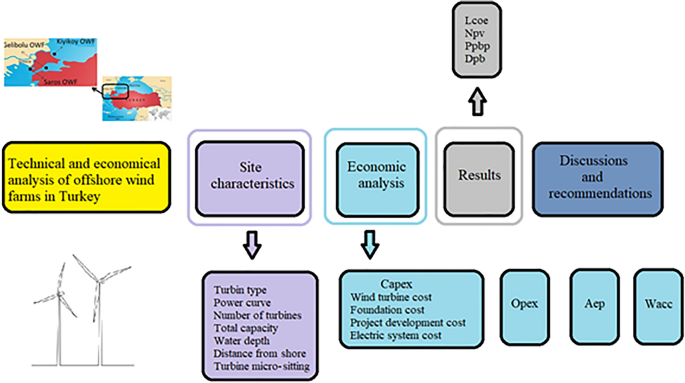
This is a preview of subscription content, log in via an institution to check access.
Access this article
Price includes VAT (Russian Federation)
Instant access to the full article PDF.
Rent this article via DeepDyve
Institutional subscriptions
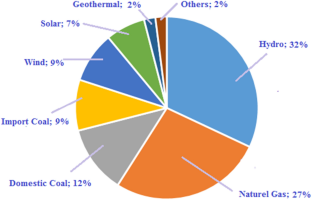
Similar content being viewed by others

A SWOT Analysis for Offshore Wind Energy Development: Turkey Case


The Future of Wind Power in Malaysia: A Review

Present Status and Target of Japanese Wind Power Generation
Data availability.
“The datasets generated during and analyzed during the current study are available in the [Global Wind Atlas] repository, [ https://globalwindatlas.info/ . Accessed 11 Nov 2021]”.
Akdağ O, Celaleddin Y (2020) An evaluation of an offshore energy installation for the Black Sea region of Turkey and the effects on a regional decrease in greenhouse gas emissions. Greenh Gases Sci Technol 544:531–544. https://doi.org/10.1002/ghg.1963
Article CAS Google Scholar
Akpinar A (2013) Evaluation of wind energy potentiality at coastal locations along the north eastern coasts of Turkey. Energy 50:395–405. https://doi.org/10.1016/j.energy.2012.11.019
Article Google Scholar
Angelopoulos D, Brückmann R, Jirouš F et al (2016) Risks and cost of capital for onshore wind energy investments in EU countries. Energy Environ 27:82–104. https://doi.org/10.1177/0958305X16638573
Angelopoulos D, Doukas H, Psarras J, Stamtsis G (2017) Risk-based analysis and policy implications for renewable energy investments in Greece. Energy Policy 105:512–523. https://doi.org/10.1016/j.enpol.2017.02.048
Apostoleris H, Sgouridis S, Stefancich M, Chiesa M (2018) Evaluating the factors that led to low-priced solar electricity projects in the Middle East. Nat Energy 3:1109–1114. https://doi.org/10.1038/s41560-018-0256-3
Ardani K, Seif D, Davidson C et al (2013b) Preliminary non-hardware ('soft’) cost-reduction Roadmap for residential and small commercial solar photovoltaics, 2013–2020. Conf Rec IEEE Photovolt Spec Conf. https://doi.org/10.1109/PVSC.2013.6745192
Ardani K, Davidson C, Truitt S, et al (2013a) Non-hardware cost reduction roadmap to 2020 for residential and commercial PV: Preliminary findings. In: 42nd ASES National Solar Conference 2013a, SOLAR 2013a. pp 14–25
Argin M, Yerci V (2017) Offshore wind power potential of the Black Sea region in Turkey. Int J Green Energy 14:811–818. https://doi.org/10.1080/15435075.2017.1331443
Argin M, Yerci V, Erdogan N et al (2019) Exploring the offshore wind energy potential of Turkey based on multi-criteria site selection. Energy Strategy Rev 23:33–46. https://doi.org/10.1016/j.esr.2018.12.005
Argin M, Yerci V (2016) The assessment of offshore wind power potential of Turkey. In: 2015 9th International Conference on Electrical and Electronics Engineering (ELECO) https://doi.org/10.1109/ELECO.2015.7394519
Aslan A (2020) Comparison based on the technical and economical analysis of wind energy potential at onshore, coastal, and offshore locations in Çanakkale. Turkey J Renew Sustain Energy. https://doi.org/10.1063/5.0025753
Bilgili M, Alphan H (2022) Global growth in offshore wind turbine technology. Clean Technol Environ Policy. https://doi.org/10.1007/s10098-022-02314-0
Bilgili M, Yildirim A, Ozbek A et al (2021) Long short-term memory (LSTM) neural network and adaptive neuro-fuzzy inference system (ANFIS) approach in modeling renewable electricity generation forecasting. Int J Green Energy 18:578–594. https://doi.org/10.1080/15435075.2020.1865375
Cali U, Erdogan N, Kucuksari S, Argin M (2018) TECHNO-ECONOMIC analysis of high potential offshore wind farm locations in Turkey. Energy Strateg Rev 22:325–336. https://doi.org/10.1016/j.esr.2018.10.007
Danish Energy Agency (2018) Note on technology costs for offshore wind farms and the background for updating CAPEX and OPEX in the technology catalogue datasheets. In: Danish Minist Energy, Util Clim 11
Deveci M, Ozcan E, John R (2020) Offshore wind farms: A fuzzy approach to site selection in a black sea region. In: 2020 IEEE Texas Power and Energy Conference (TPEC). https://doi.org/10.1109/TPEC48276.2020.9042530
Dicorato M, Forte G, Pisani M, Trovato M (2011) Guidelines for assessment of investment cost for offshore wind generation. Renew Energy 36:2043–2051. https://doi.org/10.1016/j.renene.2011.01.003
Dobrotkova Z, Surana K, Audinet P (2018) The price of solar energy: comparing competitive auctions for utility-scale solar PV in developing countries. Energy Policy 118:133–148. https://doi.org/10.1016/j.enpol.2018.03.036
Donovan C, Nuñez L (2012) Figuring what’s fair: the cost of equity capital for renewable energy in emerging markets. Energy Policy 40:49–58. https://doi.org/10.1016/j.enpol.2010.06.060
Egli F, Steffen B, Schmidt TS (2018) A dynamic analysis of financing conditions for renewable energy technologies. Nat Energy 3:1084–1092. https://doi.org/10.1038/s41560-018-0277-y
Egli F, Polzin F, Sanders M et al (2022) Financing the energy transition: four insights and avenues for future research. Environ Res Lett 17:051003. https://doi.org/10.1088/1748-9326/ac6ada
Emeksiz C, Demirci B (2019) The determination of offshore wind energy potential of Turkey by using novelty hybrid site selection method. Sustain Energy Technol Assess 36:100562. https://doi.org/10.1016/j.seta.2019.100562
Estache A, Steichen AS (2015) Is Belgium overshooting in its policy support to cut the cost of capital of renewable sources of energy? Reflets Perspect La Vie Econ 54:33–45. https://doi.org/10.3917/rpve.541.0033
Fama EF, French KR (1993) Common risk factors in the returns on stocks and bonds. J Financ Econ. https://doi.org/10.1016/0304-405X(93)90023-5
Genç MS, Karipoğlu F, Koca K, Azgın ŞT (2021) Suitable site selection for offshore wind farms in Turkey’s seas: GIS-MCDM based approach. Earth Sci Informatics 14:1213–1225. https://doi.org/10.1007/s12145-021-00632-3
Gönül Ö, Duman AC, Deveci K, Güler Ö (2021) An assessment of wind energy status, incentive mechanisms and market in Turkey. Eng Sci Technol Int J. https://doi.org/10.1016/j.jestch.2021.03.016
Güner F, Zenk H, Başer V (2021) Evaluation of offshore wind power plant sustainability: a case study of Sinop/Gerze. Turkey Int J Glob Warm 23:370. https://doi.org/10.1504/ijgw.2021.10037023
Güzel B (2012) Offshore wind energy,feasibility study guidelines with bozcaada and gokceada case study. Istanbul Technical University
Google Scholar
GWA Global Wind Atlas. https://globalwindatlas.info
Hirth L, Steckel JC (2016) The role of capital costs in decarbonizing the electricity sector. Environ Res Lett. https://doi.org/10.1088/1748-9326/11/11/114010
Ilhan A, Bilgili M (2016) An overview of Turkey ’ s offshore wind energy potential evaluations. Turkish J Sci Rev 9:55–58
Ilkiliç C, Aydin H (2015) Wind power potential and usage in the coastal regions of Turkey. Renew Sustain Energy Rev 44:78–86. https://doi.org/10.1016/j.rser.2014.12.010
IRENA (2020) Renewable Energy Statistics 2020. Renewable hydropower (including mixed plants)
IRENA (2021) Offshore renewables: an action agenda for deployment
Kitzing L, Weber C (2015) Support Mechanisms for Renewables : How Risk Exposure. Int J Sustain Energy Plan Manag 07:117–134. https://doi.org/10.5278/ijsepm.2015.7.9
Köroğlu MÖ (2011) Design principles of offshore wind plants with connection to grid via high voltage alternate current and high voltage direct current. Ege University
Krupa J, Harvey LDD (2017) Renewable electricity finance in the United States: a state-of-the-art review. Energy 135:913–929. https://doi.org/10.1016/j.energy.2017.05.190
Kumar S, Anisuzaman M, Das P (2017) Estimating the low-carbon technology deployment costs and INDC targets. Springer Singapore, Singapore
Book Google Scholar
Kumar A, Pal D, Kar SK et al (2022) An overview of wind energy development and policy initiatives in India. Clean Technol Environ Policy. https://doi.org/10.1007/s10098-021-02248-z
Lorenzoni A, Bano L (2009) Renewable electricity costs in Italy: an estimation of the cost of operating in an uncertain world. Int J Environ Pollut 39:92–111. https://doi.org/10.1504/IJEP.2009.027145
Lozer dos Reis MM, Mitsuo Mazetto B, Malateaux C, da Silva E (2021) Economic analysis for implantation of an offshore wind farm in the Brazilian coast. Sustain Energy Technol Assess 43:100955. https://doi.org/10.1016/j.seta.2020.100955
Mazzucato M, Semieniuk G (2018) Financing renewable energy: who is financing what and why it matters. Technol Forecast Soc Change 127:8–22. https://doi.org/10.1016/j.techfore.2017.05.021
Ozdilim AM (2017) Technical and economic analysis of potential offshore wind farms in Turkey. Yildiz Technical University
Pacheco A, Gorbeña E, Sequeira C, Jerez S (2017) An evaluation of offshore wind power production by floatable systems: a case study from SW Portugal. Energy 131:239–250. https://doi.org/10.1016/j.energy.2017.04.149
Polzin F, Egli F, Steffen B, Schmidt TS (2019) How do policies mobilize private finance for renewable energy? A systematic review with an investor perspective. Appl Energy 236:1249–1268. https://doi.org/10.1016/j.apenergy.2018.11.098
Polzin F, Sanders M, Steffen B et al (2021) The effect of differentiating costs of capital by country and technology on the European energy transition. Clim Change 167:1–21. https://doi.org/10.1007/s10584-021-03163-4
Pyakurel M, Nawandar K, Ramadesigan V, Bandyopadhyay S (2021) Capacity expansion of power plants using dynamic energy analysis. Clean Technol Environ Policy 23:669–683. https://doi.org/10.1007/s10098-020-01995-9
Rechsteiner R (2021) German energy transition (Energiewende) and what politicians can learn for environmental and climate policy. Springer, Berlin Heidelberg
REN21 (2017) Renewables 2017 Global Status Report
Rinaldi F, Moghaddampoor F, Najafi B, Marchesi R (2021) Economic feasibility analysis and optimization of hybrid renewable energy systems for rural electrification in Peru. Clean Technol Environ Policy 23:731–748. https://doi.org/10.1007/s10098-020-01906-y
Roth A, Brückmann R, Jimeno M, et al (2021) Renewable energy financing conditions in Europe
Rubio-Domingo G, Linares P (2021) The future investment costs of offshore wind: an estimation based on auction results. Renew Sustain Energy Rev 148:111324. https://doi.org/10.1016/j.rser.2021.111324
Satir M, Murphy F, McDonnell K (2018) Feasibility study of an offshore wind farm in the Aegean Sea, Turkey. Renew Sustain Energy Rev 81:2552–2562. https://doi.org/10.1016/j.rser.2017.06.063
Sharma R (2016) Master in International Finance and Economics WS 2013 Papers in Applied Research Project Economic and Financial Evaluation of the Offshore Wind Project in the United Kingdom. pp 0–90. https://doi.org/10.13140/RG.2.1.3775.4001
Shrimali G, Nelson D, Goel S et al (2013) Renewable deployment in India: Financing costs and implications for policy. Energy Policy 62:28–43. https://doi.org/10.1016/j.enpol.2013.07.071
Steffen B (2020) Estimating the cost of capital for renewable energy projects. Energy Econ 88:104783. https://doi.org/10.1016/j.eneco.2020.104783
Steffen B, Waidelich P (2022) Determinants of cost of capital in the electricity sector. Prog Energy 4:033001. https://doi.org/10.1088/2516-1083/ac7936
Stocks KJ (1984) Discount rate for technology assessment. Energy Econ 6:177–185. https://doi.org/10.1016/0140-9883(84)90014-8
Sweerts B, Longa FD, van der Zwaan B (2019) Financial de-risking to unlock Africa’s renewable energy potential. Renew Sustain Energy Rev 102:75–82. https://doi.org/10.1016/j.rser.2018.11.039
Szabó S, Jäger-Waldau A, Szabó L (2010) Risk adjusted financial costs of photovoltaics. Energy Policy 38:3807–3819. https://doi.org/10.1016/j.enpol.2010.03.001
Telli A, Erat S, Demir B (2021) Comparison of energy transition of Turkey and Germany: energy policy, strengths/weaknesses and targets. Clean Technol Environ Policy 23:413–427. https://doi.org/10.1007/s10098-020-01950-8
Tercan E, Tapkın S, Latinopoulos D et al (2020) A GIS-based multi-criteria model for offshore wind energy power plants site selection in both sides of the Aegean Sea. Environ Monit Assess. https://doi.org/10.1007/s10661-020-08603-9
TMMOB (2021) Türkiye elektrik istatistikleri ŞUBAT 2021
Tobias S (2014) Low-carbon investment risks and derisiking. Nat Clim Change 4:237–239
Tsvetkova O, Ouarda TBMJ (2021) A review of sensitivity analysis practices in wind resource assessment. Energy Convers Manage 238:114112. https://doi.org/10.1016/j.enconman.2021.114112
Voormolen JA, Junginger HM, van Sark WGJHM (2016) Unravelling historical cost developments of offshore wind energy in Europe. Energy Policy 88:435–444. https://doi.org/10.1016/j.enpol.2015.10.047
Walter Musial NREL (NREL), Paul Spitsen, Philipp Beiter, et al (2020) Offshore Wind Market Report: 2021 Edition. Dep Energy. pp 0–1
Wood TB, Ross NC (2012) The financial cost of wind energy: a multi-national case study. Nov Sci Pub Inc
World Bank (2019) Going global-expanding offshore wind to emerging markets. Esmap. 1–44
Xiang C, Chen F, Wen F, Song F (2021) Can China’s offshore wind power achieve grid parity in time? Int J Green Energy 18:1219–1228. https://doi.org/10.1080/15435075.2021.1897828
Download references
Acknowledgements
I would like to acknowledge Prof. Dr. Mehmet Bilgili from Cukurova University, Ceyhan Engineering Faculty, Department of Mechanical Engineering.
The author did not receive support from any organization for the submitted work.
Author information
Authors and affiliations.
Department of Machinery and Metal Technology, Osmaniye Korkut Ata University, 80000, Osmaniye, Turkey
Alper Yildirim
You can also search for this author in PubMed Google Scholar
Corresponding author
Correspondence to Alper Yildirim .
Ethics declarations
Conflict of interest.
The author has no conflicts of interest to disclose.
Additional information
Publisher's note.
Springer Nature remains neutral with regard to jurisdictional claims in published maps and institutional affiliations.
Rights and permissions
Springer Nature or its licensor holds exclusive rights to this article under a publishing agreement with the author(s) or other rightsholder(s); author self-archiving of the accepted manuscript version of this article is solely governed by the terms of such publishing agreement and applicable law.
Reprints and permissions
About this article
Yildirim, A. The technical and economical feasibility study of offshore wind farms in Turkey. Clean Techn Environ Policy 25 , 125–142 (2023). https://doi.org/10.1007/s10098-022-02392-0
Download citation
Received : 29 March 2022
Accepted : 20 August 2022
Published : 07 September 2022
Issue Date : January 2023
DOI : https://doi.org/10.1007/s10098-022-02392-0
Share this article
Anyone you share the following link with will be able to read this content:
Sorry, a shareable link is not currently available for this article.
Provided by the Springer Nature SharedIt content-sharing initiative
- Economic analysis
- Offshore wind energy costs
- Renewable energy
- Site selection
- Find a journal
- Publish with us
- Track your research
Short-Term Wind Speed Prediction Using GMDH Neural Networks: Binalood Wind Farm Case Study
Ieee account.
- Change Username/Password
- Update Address
Purchase Details
- Payment Options
- Order History
- View Purchased Documents
Profile Information
- Communications Preferences
- Profession and Education
- Technical Interests
- US & Canada: +1 800 678 4333
- Worldwide: +1 732 981 0060
- Contact & Support
- About IEEE Xplore
- Accessibility
- Terms of Use
- Nondiscrimination Policy
- Privacy & Opting Out of Cookies
A not-for-profit organization, IEEE is the world's largest technical professional organization dedicated to advancing technology for the benefit of humanity. © Copyright 2024 IEEE - All rights reserved. Use of this web site signifies your agreement to the terms and conditions.

More onshore wind farms in Wales unlikely to halt red kite recovery – study
D eveloping more onshore wind farms in Wales is unlikely to stop the recovery of the country’s red kite population, research suggests.
A study carried out to assess the impact of the onshore wind schemes planned across the Welsh landscape on the birds of prey found numbers would likely continue to increase, though the rate of growth might slow.
Red kites, birds of prey that mostly feed on carrion, were once widespread but declined in the face of persecution to become extinct in Scotland and England by the late 19th century, while just clinging on in mid-Wales with a few pairs.
Numbers remained low until starting to recover over the last three or four decades, and there are now around 2,000-2,500 pairs in Wales, with the population continuing to increase.
Meanwhile reintroductions in England and Scotland have seen the birds return to swathes of Britain.
But with plans for more onshore wind farms in the pipeline in Wales, concerns have been raised over the impact the turbines – which can kill birds that collide with their blades – could have on the recovering population in the country.
A study led by the British Trust for Ornithology (BTO) and BSG Ecology, funded by industry body RenewableUK Cymru, modelled the potential impacts of current and proposed wind farm developments, including those at an early stage, on the Welsh population of red kites.
The analysis found that while commissioning the suite of wind farm projects currently in development might slow down the growth in the numbers of red kites, it was very unlikely to lead to national population declines in Wales.
But impacts were more likely in areas of high turbine density, which is relevant to two special protected areas (SPAs) that have been designated because of their red kite populations.
The study said “greater caution” is justified for developments close to those areas, to minimise risk to their high density populations of red kites.
Given the history of the species in Wales, there's understandably a precautious approach to anything that might harm that recovery
Callum Macgregor, senior research ecologist for the BTO and study author, said: “There’s fairly good data that not many red kites get knocked out of the sky by wind farms, and most of them are quite good at seeing wind turbines and flying round them, though not all.”
But he added: “Given the history of the species in Wales, there’s understandably a precautious approach to anything that might harm that recovery.
“That’s where the concern comes from, if red kites do occasionally fly into turbines and are killed by them, what does that mean for the red kite population in the long term if we start putting them in?”
The study modelled survival and productivity rates for red kites, comparing them to what was known about the population in Wales from conservation surveying to assess which models were likely to apply in the country.
It made estimates for changes in survival rates that could occur if more wind farms were put in the landscape.
Dr Macgregor said the study found “building these future wind farms that are in various stages of development will probably slow the growth (in red kite numbers), but it’s not likely to slow it down so much that you end up with the population stabilising or declining”.
In the Elenydd-Mallaen SPA in mid-Wales where there is a high density of red kites, there was a small (4%) possibility of the population declining if all planned wind farms were built, he added.
He said there was reason for decision-makers to continue to think about the SPAs in developing wind farms, but he said: “Our results do not lead to a great deal of concern around the SPAs, though slightly more concern than for the population at national scale.”
Owain Gabb, director at BSG Ecology, said “It has been a pleasure to see the openness of the renewables industry in Wales to engaging with this project.
“The study demonstrates that with appropriate consideration at the design stage, wind farms are unlikely to affect Welsh red kite populations at the regional or national level, which is a very positive outcome.”
The Independent is the world’s most free-thinking news brand, providing global news, commentary and analysis for the independently-minded. We have grown a huge, global readership of independently minded individuals, who value our trusted voice and commitment to positive change. Our mission, making change happen, has never been as important as it is today.

VicGrid announces study area for new transmission lines to connect offshore wind to grid in Gippsland
The government agency planning the route of transmission lines for offshore wind in Gippsland has ruled out putting the lines underground.
VicGrid on Friday announced its study area for the new transmission infrastructure that will be needed to connect new offshore wind projects to the electricity grid in the Latrobe Valley.
The study area starts about 6km from the coast near Giffard and travels north-west past Stradbroke West to Willung, across to Flynns Creek and on to the Loy Yang Power Station in the Latrobe Valley.
VicGrid chief executive Alistair Parker said the study area had been decided after feedback from landholders.
The area being looked at will affect 300 landholders.
"This particular study area has a lower proportion of agricultural and private land than other options," Mr Parker said.
"It also allows us to explore other options with the existing Basslink route."
VicGrid said the project would form a key part of the state's power supply as coal-fired power stations closed down and the government worked towards its renewable energy target of 50 per cent by 2030.
While the final route is yet to be finalised, the agency has confirmed the powerlines will go overhead due to costs.
Analysis shows that putting the project underground will cost up to $4.5 billion compared with the estimated $700 million to $1.5 billion for overhead.
"We've really looked at this for this project and being really mindful of that impact on consumers," Mr Parker said.
"We didn't feel able to make that choice [to put powerlines underground]."
One of many corridors
The announcement is separate to the previously planned Gippsland Renewable Energy Zone (G-REZ) project, which is an Ausnet-led idea for a similar power corridor that the company has been working on since 2022.
The G-REZ project was to run along a similar route, with Ausnet conducting preparatory works with landholders and engaging in discussions with stakeholders.
The future of that particular project is now unclear due to the VicGrid announcement.
In a statement, AusNet said it would "work to understand in further detail what this means for the G-REZ project".
Mr Parker said the long-term target of the government to have 9GW of offshore wind eventually connected would likely need additional grid connections.
If successful, the current project will be able to provide 2GW to the grid, meaning there could be multiple transmission routes in the future.
"In the [technical] report, we talk about the need for potentially a second corridor back to the Latrobe Valley and potentially a tie line between the connection points," Mr Parker said.
Farmers say they won't give up
Kirra Bott chairs the Better Transmission for Gippsland group, which has been vocal in its opposition to overhead power lines.
Ms Bott, whose family runs farms at Seaspray and Stradbroke, said farmers were disappointed by the announcement.
She said farmers were asking why the state government was not following similar precedents set by projects such as the Star of the South which, if finalised, planned to have transmission cables underground.
In an update to its website, Star of the South said it was reviewing the latest government announcement to "understand what it means" for its project.
Ms Bott said the fight was far from over.
"We won't give up on arguing that this is possible and trying our best to get the best transmission future for our kids," she said.
ABC Gippsland — local news in your inbox
- X (formerly Twitter)
Related Stories
Tractors take to the streets as farmers protest western renewables link.
Federal rejection of Victorian renewable proposal a bump in the road, proponents say
Government's 'milestone' offshore wind energy project changed amid community concerns
- Alternative Energy
- Energy Industry

Rosatom starts production of rare-earth magnets for wind power generation
November 11, 2020 5:17 pm

T VEL Fuel Company of Rosatom has started gradual localization of rare-earth magnets manufacturing for wind power plants generators. The first sets of magnets have been manufactured and shipped to the customer.
In total, the contract between Elemash Magnit LLC (an enterprise of TVEL Fuel Company of Rosatom in Elektrostal, Moscow region) and Red Wind B.V. (a joint venture of NovaWind JSC and the Dutch company Lagerwey) foresees manufacturing and supply over 200 sets of magnets. One set is designed to produce one power generator.
“The project includes gradual localization of magnets manufacturing in Russia, decreasing dependence on imports. We consider production of magnets as a promising sector for TVEL’s metallurgical business development. In this regard, our company does have the relevant research and technological expertise for creation of Russia’s first large-scale full cycle production of permanent rare-earth magnets,” commented Natalia Nikipelova, President of TVEL JSC.
“NovaWind, as the nuclear industry integrator for wind power projects, not only made-up an efficient supply chain, but also contributed to the development of inter-divisional cooperation and new expertise of Rosatom enterprises. TVEL has mastered a unique technology for the production of magnets for wind turbine generators. These technologies will be undoubtedly in demand in other areas as well,” noted Alexander Korchagin, Director General of NovaWind JSC.
Cookie Consent EPR Magazine
We use cookies to personalize your experience. By continuing to visit this website you agree to our Terms & Conditions , Privacy Policy and Cookie Policy .
Related Posts:

EPR EMagazine March 2024

Our Sponsors

Notification: View the latest site access restrictions, updates, and resources related to the coronavirus (COVID-19) »
Connecting the Dots: Putting Offshore Wind Energy to Work
Researchers identify optimal ways to connect offshore wind farms to benefit the grid in coastal regions.
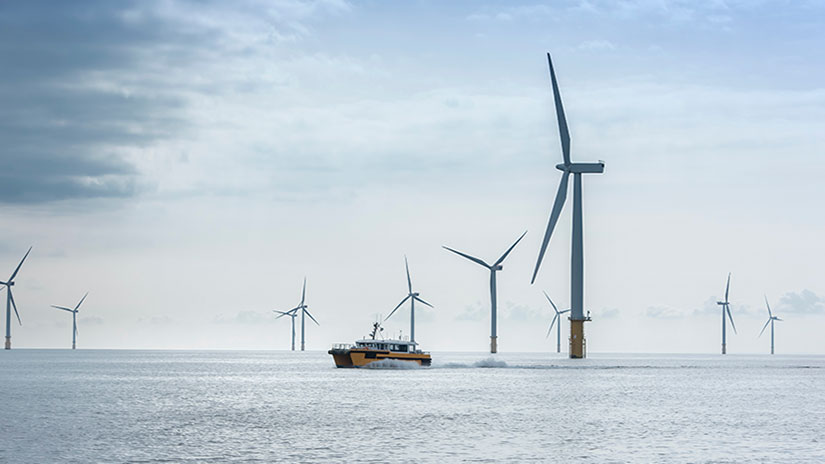
A new study determined ideal scenarios for connecting future offshore wind projects to East Coast communities. Photo from Getty Images
The most recent U.S. Census states that 44.4 million people , or nearly 14% of the population, live along the Atlantic Coast. That is a lot of people—who need a lot of electricity. And as the country pushes to decarbonize the energy sector, that power needs to increasingly come from renewable sources, like solar and wind.
But densely populated coastlines often do not have the space needed for large solar or wind farms. That is why developers and scientists are looking to offshore wind energy to play a key role in supporting a low-carbon future for East Coast communities. And that is also why researchers at the National Renewable Energy Laboratory (NREL) and the Pacific Northwest National Laboratory (PNNL) have spent two years evaluating transmission options to make the best possible connections between offshore wind projects and communities on the Atlantic Coast.
The Atlantic Offshore Wind Transmission Study was the most thorough analysis to date of options for bringing offshore wind energy onshore to communities on the Atlantic Coast.
The goal of the study was to identify ways to facilitate transmission of offshore wind energy to areas of high demand and reduce grid congestion, increase system reliability, maximize production, and reduce costs for consumers.
The study also informed the concurrently released Atlantic Offshore Wind Transmission Action Plan , which outlines immediate actions the United States needs to do to connect the first generation of Atlantic offshore wind power projects to the electric grid and how they can increase transmission in the next several decades.
The Benefits of Interconnection
Study authors outlined one significant step that would help lower electricity costs and enhance U.S. grid reliability—while reducing disruption to ecosystems or other ocean users. The step? Linking offshore wind energy projects to each other first rather than connecting them individually to the grid back on land.
“We found that the benefits of connecting offshore wind energy stations outweigh the costs of installing those individual connections by a ratio of 2:1 or more,” said Greg Brinkman, an NREL senior research engineer and co-author of the report along with Dave Corbus, an NREL power systems engineer, and colleagues from PNNL. “Creating these transmission networks would yield substantial savings when compared to a scenario in which each project has its own isolated transmission connections.”
To then get energy from those networks of offshore wind farms back to land, the team identified potential transmission “corridors”—sites that avoid location constraints such as military zones and shipping channels, as well as marine protected areas and artificial reefs.
The study, which was based on a target of deploying 85 gigawatts of offshore wind off the Atlantic Coast by 2050, found that building offshore transmission in phases could help reduce risks. Study authors also suggested that the nation implement standards for high-voltage direct current technology early in the process to help developers lay new transmission lines and expand those networks in the future.
The Atlantic Offshore Wind Transmission Study was funded by the U.S. Department of Energy’s Wind Energy Technologies Office. The Atlantic Offshore Wind Transmission Action Plan was led by the U.S. Department of Energy’s Grid Deployment Office in partnership with the Wind Energy Technologies Office and the U.S. Department of Interior’s Bureau of Ocean Management.
Learn more about the Atlantic Offshore Wind Transmission Study and subscribe to NREL’s Leading Edge newsletter for more wind energy news.
- Nuclear fuel cycle
- Key figures
- History of cooperation
- Areas of cooperation
- Office profile
- Procurement standard
- Useful links
- How to become a supplier
- Procurement
- Rosatom in media
- Photo and video
- Rosatom Newsletter
- Anti-corruption policy
© 2008–2024 The State Atomic Energy Corporation ROSATOM

- Rosatom Global presence
- Rosatom in region
- Regional office
- For suppliers
- Preventing corruption
- Press centre
Rosatom starts production of rare-earth magnets for wind power generation
- 05 November, 2020 / 18:04
This site uses cookies. By continuing your navigation, you accept the use of cookies. For more information, or to manage or to change the cookies parameters on your computer, read our Cookies Policy. Learn more

Rosatom Starts Production of Rare-Earth Magnets for Wind Power Generation
TVEL Fuel Company of Rosatom has started gradual localization of rare-earth magnets manufacturing for wind power plants generators. The first sets of magnets have been manufactured and shipped to the customer.
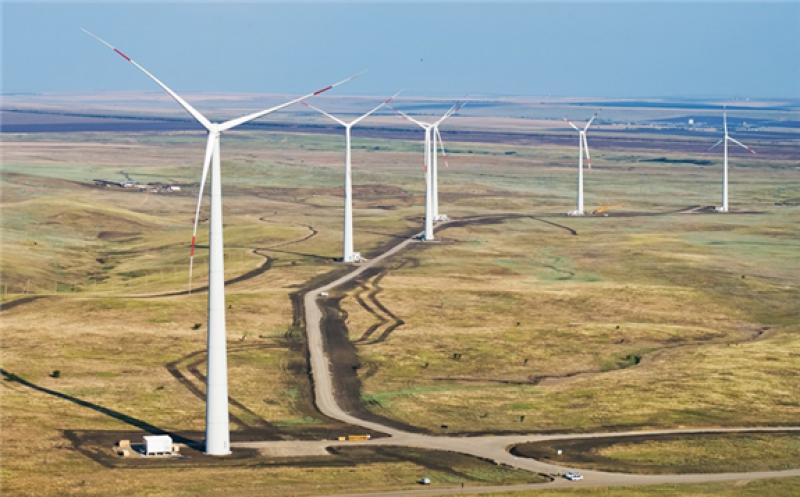
In total, the contract between Elemash Magnit LLC (an enterprise of TVEL Fuel Company of Rosatom in Elektrostal, Moscow region) and Red Wind B.V. (a joint venture of NovaWind JSC and the Dutch company Lagerwey) foresees manufacturing and supply over 200 sets of magnets. One set is designed to produce one power generator.
“The project includes gradual localization of magnets manufacturing in Russia, decreasing dependence on imports. We consider production of magnets as a promising sector for TVEL’s metallurgical business development. In this regard, our company does have the relevant research and technological expertise for creation of Russia’s first large-scale full cycle production of permanent rare-earth magnets,” commented Natalia Nikipelova, President of TVEL JSC.
“NovaWind, as the nuclear industry integrator for wind power projects, not only made-up an efficient supply chain, but also contributed to the development of inter-divisional cooperation and new expertise of Rosatom enterprises. TVEL has mastered a unique technology for the production of magnets for wind turbine generators. These technologies will be undoubtedly in demand in other areas as well,” noted Alexander Korchagin, Director General of NovaWind JSC.
For reference:
TVEL Fuel Company of Rosatom incorporates enterprises for the fabrication of nuclear fuel, conversion and enrichment of uranium, production of gas centrifuges, as well as research and design organizations. It is the only supplier of nuclear fuel for Russian nuclear power plants. TVEL Fuel Company of Rosatom provides nuclear fuel for 73 power reactors in 13 countries worldwide, research reactors in eight countries, as well as transport reactors of the Russian nuclear fleet. Every sixth power reactor in the world operates on fuel manufactured by TVEL. www.tvel.ru
NovaWind JSC is a division of Rosatom; its primary objective is to consolidate the State Corporation's efforts in advanced segments and technological platforms of the electric power sector. The company was founded in 2017. NovaWind consolidates all of the Rosatom’s wind energy assets – from design and construction to power engineering and operation of wind farms.
Overall, by 2023, enterprises operating under the management of NovaWind JSC, will install 1 GW of wind farms. http://novawind.ru
Elemash Magnit LLC is a subsidiary of Kovrov Mechanical Plant (an enterprise of the TVEL Fuel Company of Rosatom) and its main supplier of magnets for production of gas centrifuges. The company also produces magnets for other industries, in particular, for the automotive
industry. The production facilities of Elemash Magnit LLC are located in the city of Elektrostal, Moscow Region, at the site of Elemash Machine-Building Plant (a nuclear fuel fabrication facility of TVEL Fuel Company).
Rosatom is a global actor on the world’s nuclear technology market. Its leading edge stems from a number of competitive strengths, one of which is assets and competences at hand in all nuclear segments. Rosatom incorporates companies from all stages of the technological chain, such as uranium mining and enrichment, nuclear fuel fabrication, equipment manufacture and engineering, operation of nuclear power plants, and management of spent nuclear fuel and nuclear waste. Nowadays, Rosatom brings together about 350 enterprises and organizations with the workforce above 250 K. https://rosatom.ru/en/
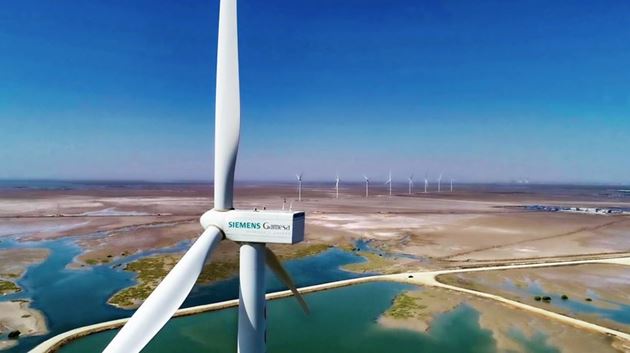
Wind Energy Going Strong in Oklahoma
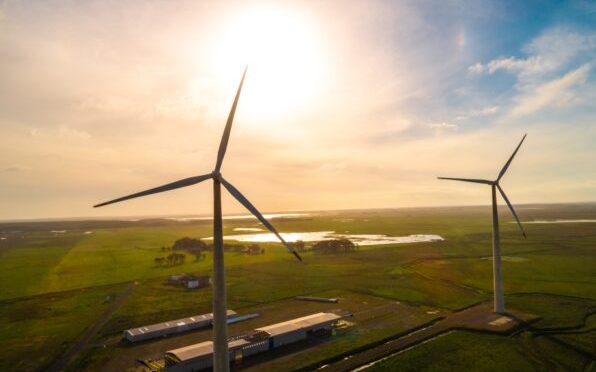
Arcelormittal and Casa Dos Ventos Will Invest in Wind Power in Bahia, Brazil
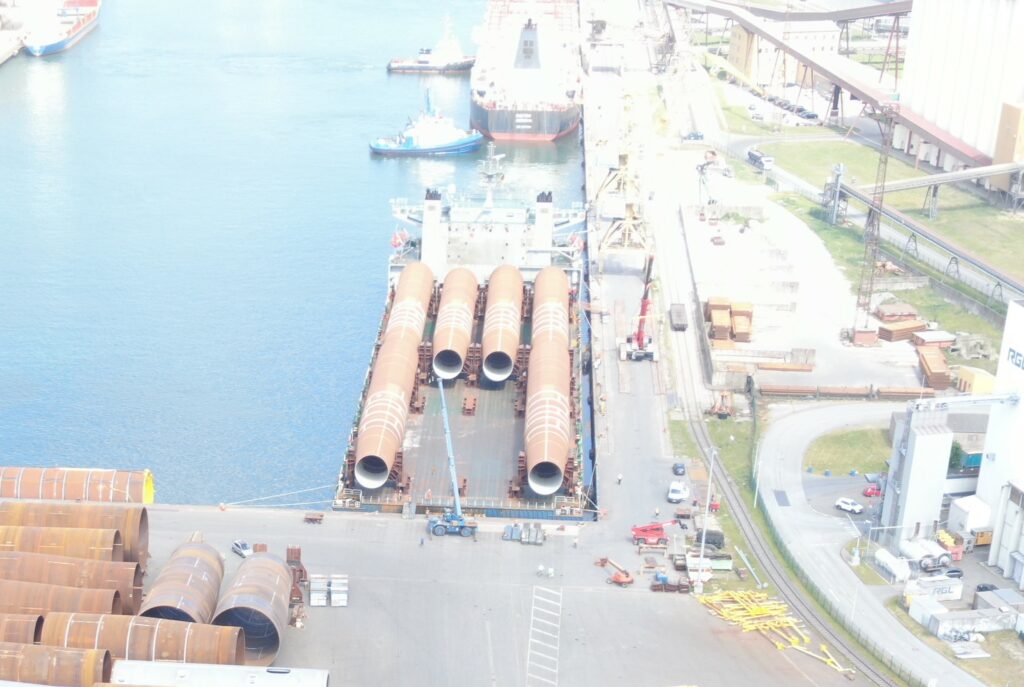
Final Monopiles Delivered for 450 MW French Offshore Wind Project
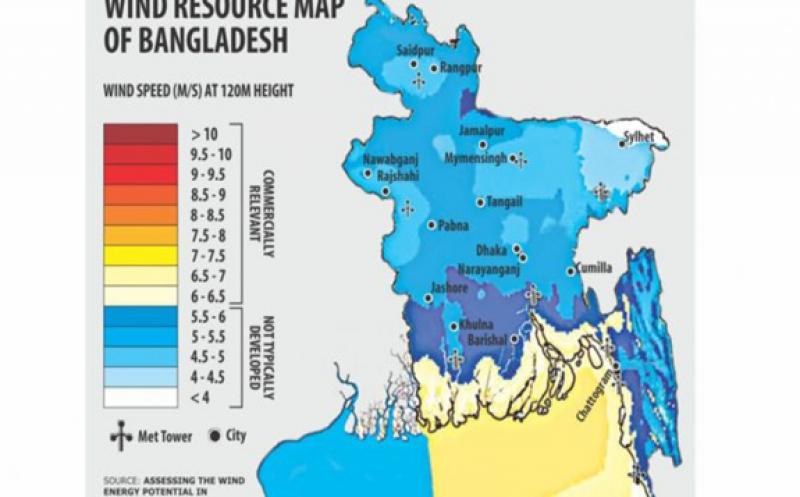
Bangladesh Approves First Major Wind Power Plant
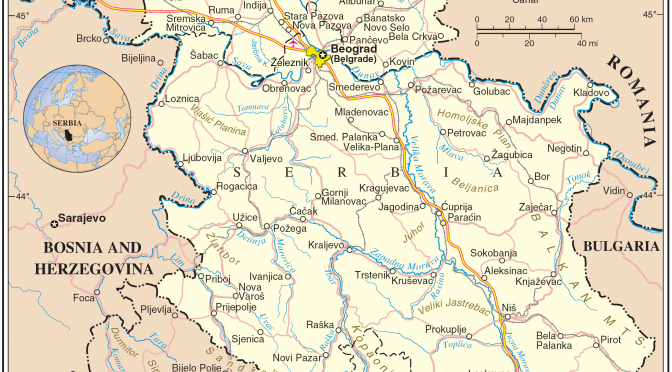
Windey to Supply Wind Turbines for 854 MW Wind Farm Project in Serbia
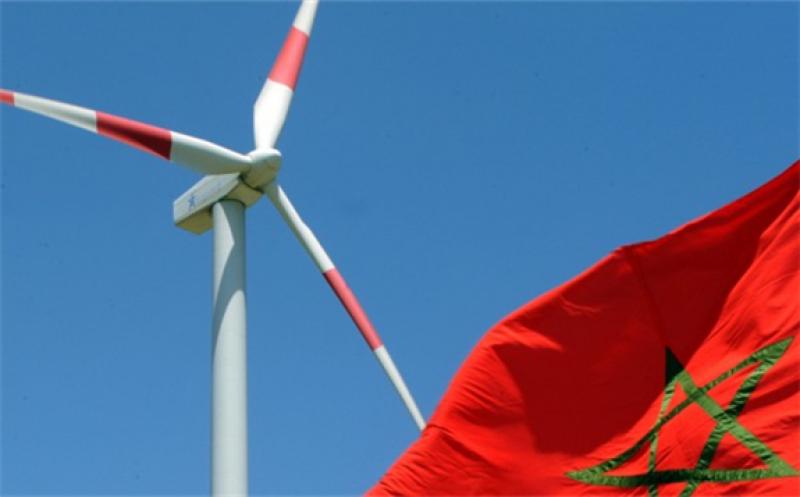
Morocco to Build 270 MW Wind Farm Near Essaouira

For the first time Rosatom Fuel Division supplied fresh nuclear fuel to the world’s only floating nuclear cogeneration plant in the Arctic
The fuel was supplied to the northernmost town of Russia along the Northern Sea Route.

The first in the history of the power plant refueling, that is, the replacement of spent nuclear fuel with fresh one, is planned to begin before 2024. The manufacturer of nuclear fuel for all Russian nuclear icebreakers, as well as the Akademik Lomonosov FNPP, is Machinery Manufacturing Plant, Joint-Stock Company (MSZ JSC), a company of Rosatom Fuel Company TVEL that is based in Elektrostal, Moscow Region.
The FNPP includes two KLT-40S reactors of the icebreaking type. Unlike convenient ground-based large reactors (that require partial replacement of fuel rods once every 12-18 months), in the case of these reactors, the refueling takes place once every few years and includes unloading of the entire reactor core and loading of fresh fuel into the reactor.
The cores of KLT-40 reactors of the Akademik Lomonosov floating power unit have a number of advantages compared to the reference ones: a cassette core was used for the first time in the history of the unit, which made it possible to increase the fuel energy resource to 3-3.5 years between refuelings, and also reduce the fuel component of the electricity cost by one and a half times. The FNPP operating experience formed the basis for the designs of reactors for nuclear icebreakers of the newest series 22220. Three such icebreakers have been launched by now.
For the first time the power units of the Akademik Lomonosov floating nuclear power plant were connected to the grid in December 2019, and put into commercial operation in May 2020. The supply of nuclear fuel from Elektrostal to Pevek and its loading into the second reactor is planned for 2024. The total power of the Akademik Lomonosov FNPP, supplied to the coastal grid of Pevek without thermal energy consumption on shore, is about 76 MW, being about 44 MW in the maximum thermal power supply mode. The FNPP generated 194 million kWh according to the results of 2023. The population of Pevek is just a little more than 4 thousand, while the FNPP has a potential for supplying electricity to a city with a population of up to 100 thousand people. After the FNPP commissioning two goals were achieved. These include first of all the replacement of the retiring capacities of the Bilibino NPP, which has been operating since 1974, as well as the Chaunskaya TPP, which has already been operating for more than 70 years. Secondly, energy is supplied to the main mining companies in western Chukotka in the Chaun-Bilibino energy hub a large ore and metal cluster, including gold mining companies and projects related to the development of the Baimsk ore zone. In September 2023, a 110 kilovolt power transmission line with a length of 490 kilometers was put into operation, connecting the towns of Pevek and Bilibino. The line increased the reliability of energy supply from the FNPP to both Bilibino consumers and mining companies, the largest of which is the Baimsky GOK. The comprehensive development of the Russian Arctic is a national strategic priority. To increase the NSR traffic is of paramount importance for accomplishment of the tasks set in the field of cargo shipping. This logistics corridor is being developed due regular freight voyages, construction of new nuclear-powered icebreakers and modernization of the relevant infrastructure. Rosatom companies are actively involved in this work. Rosatom Fuel Company TVEL (Rosatom Fuel Division) includes companies fabricating nuclear fuel, converting and enriching uranium, manufacturing gas centrifuges, conducting researches and producing designs. As the only nuclear fuel supplier to Russian NPPs, TVEL supplies fuel for a total of 75 power reactors in 15 countries, for research reactors in nine countries, as well as for propulsion reactors of the Russian nuclear fleet. Every sixth power reactor in the world runs on TVEL fuel. Rosatom Fuel Division is the world’s largest producer of enriched uranium and the leader on the global stable isotope market. The Fuel Division is actively developing new businesses in chemistry, metallurgy, energy storage technologies, 3D printing, digital products, and decommissioning of nuclear facilities. TVEL also includes Rosatom integrators for additive technologies and electricity storage systems. Rosenergoatom, Joint-Stock Company is part of Rosatom Electric Power Division and one of the largest companies in the industry acting as an operator of nuclear power plants. It includes, as its branches, 11 operating NPPs, including the FNPP, the Scientific and Technical Center for Emergency Operations at NPPs, Design and Engineering as well as Technological companies. In total, 37 power units with a total installed capacity of over 29.5 GW are in operation at 11 nuclear power plants in Russia. Machinery Manufacturing Plant, Joint-Stock Company (MSZ JSC, Elektrostal) is one of the world’s largest manufacturers of fuel for nuclear power plants. The company produces fuel assemblies for VVER-440, VVER-1000, RBMK-1000, BN-600,800, VK-50, EGP-6; powders and fuel pellets intended for supply to foreign customers. It also produces nuclear fuel for research reactors. The plant belongs to the TVEL Fuel Company of Rosatom.

Rosatom obtained a license for the first land-based SMR in Russia
On April 21, Rosenergoatom obtained a license issued by Rostekhnadzor to construct the Yakutsk land-based SMR in the Ust-Yansky District of the Republic of Sakha (Yakutia).

ROSATOM and FEDC agree to cooperate in the construction of Russia's first onshore SNPP
ROSATOM and FEDC have signed a cooperation agreement to build Russia's first onshore SNPP in Yakutia.
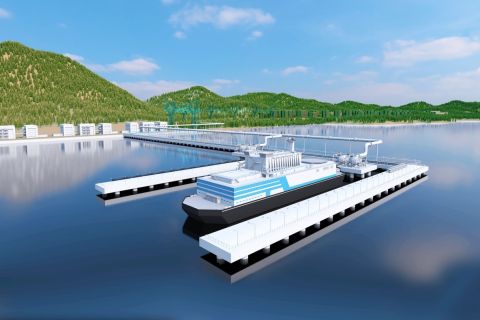
Rosatom develops nuclear fuel for modernized floating power units
Rosatom has completed the development of nuclear fuel for the RITM-200S small modular reactor designed for the upgraded floating power units.

IMAGES
COMMENTS
The Whitelee Wind Farm, located in Scotland, is one of the most important projects in Endiprev's portfolio. It is the second-largest onshore wind farm in Europe and one of the first large-scale wind farms close to a center of population. Over the years, Endiprev has performed commissioning, corrective, and preventive maintenance services on ...
Abstract. Onshore wind farms are reaching the end of their operational or consent life and we need to consider how to plan for the future. This paper draws upon detailed empirical data from four UK case studies to understand the range and impact of changes that occur over the life of operational wind farms, including economic, policy, landscape and community changes and how these changes ...
Why repowering onshore wind farms does not always lead to more wind power generation - A German case study. Author links open overlay panel Jan Frederick Unnewehr a, ... The potential for electricity generation from on-shore wind energy under the constraints of nature conservation: a case study for two regions in Germany. Renew.
Wind energy is an effective solution for achieving the carbon-neutrality target and mitigating climate change. The expansion of onshore wind energy evokes extensive attention to environmental impact in the locality. The landscape visual impact has become the critical reason for the local protest. This paper proposed a landscape visual impact evaluation (LVIE) model that combines the ...
The goal of this study is to quantify the environmental performance of an operating onshore wind farm in the Guajira peninsula of Colombia with a focus on the role of services. To fulfill this goal, we carry out such an analysis using the integrated hybrid LCA approach proposed by Suh et al. (2002) and specifically the model developed by Suh et ...
The conflict between wind energy expansion and local environmental protection has attracted attention from society and initiated a fierce discussion about the community acceptance of wind farms. There are various empirical studies on factors affecting the public acceptance of wind farms, but little concerning the correlation and significance of factors, especially in a close distance to the ...
Why repowering onshore wind farms does not always lead to more wind power generation - A German case study" by Jan Frederick Unnewehr et al. Skip to search form Skip to main content Skip to account menu. Semantic Scholar's Logo. Search 217,523,571 papers from all fields of science.
Onshore Wind Farms: A Case Study of the Zhongying Wind Farm in Eastern China Jinjin Guan * and Harald Zepp Institute of Geography, Ruhr University Bochum, 44801 Bochum, Germany; Harald.Zepp@ruhr ...
In the Jädraås Onshore Windfarm case study, CPI describes how a combination of public policies and financial instruments, and robust private risk management measures mobilized EUR 360 million of private investment in Scandinavia's largest windfarm, delivering power to 100,000 homes. Given the potential scale of institutional investment and ...
The landscape visual impact evaluation (LVIE) model has been constructed based on theoretical research and practical planning instruments. The German wind farm case study has verified the LVIE model, and the results are illustrated cartographically to demonstrate precise locations and the degree of visual impact.
A study by Tegen, et al. (2016), subdivided the wind farm development process into four separate stages - Prospecting, Early Development, Intermediate Development, and Advanced Development. This study's model ensemble compared the regulatory burden present at the time of the study with a scenario that prescribed specific wind energy
The case studies chosen are broadly indicative of their respective countries' onshore wind energy policies; Windfarm A is an example of a private enterprise with a global ownership structure a strong national identity derived in part from past nationalisation, while Windfarm B is an example of B-BBEE in action as well as a product of South ...
Scientific Reports - Correlation challenges for North Sea offshore wind power: a Norwegian case study. ... (150MW) onshore wind farm in Norway (with Gaussian filtering) and for the Hywind demo ...
Wind power is a promising renewable energy source that is rapidly expanding in the global electricity mix. This study explored suitable locations for onshore wind turbines, and estimated the wind power potential in Fujian Province, China. We also analyzed the resource occupancy of 100 years of potential wind turbine operation in terms of the materials, CO<SUB>2</SUB> emissions, land, and labor.
Sunrise Wind today received its Record of Decision (RoD) from the US Department of the Interior's Bureau of Ocean Energy Management (BOEM), crossing a critical milestone in the federal environmental review process for the offshore wind project serving New York. Additionally, Ørsted and Eversource today announced they have jointly taken a final investment decision on Sunrise Wind, solidifying ...
Kiyikoy currently has two onshore wind farms with an overall capacity of 73 MW. ... Wood TB, Ross NC (2012) The financial cost of wind energy: a multi-national case study. Nov Sci Pub Inc. World Bank (2019) Going global-expanding offshore wind to emerging markets. Esmap. 1-44.
Short-Term Wind Speed Prediction Using GMDH Neural Networks: Binalood Wind Farm Case Study Abstract: Smart grid is remarkably recognized by the dominant role of renewable sources of energy. Wind energy is considered as one of the main sources of renewable energy and has the most contribution in global energy generation among other renewable ...
D eveloping more onshore wind farms in Wales is unlikely to stop the recovery of the country's red kite population, research suggests.. A study carried out to assess the impact of the onshore ...
This research project explored the technical feasibility of utilizing an offshore wind farm as a supplementary power source to several electrical grids of offshore oil and gas platforms and providing surplus power to an onshore grid. Three case studies comprising wind farms rated at 20 MW, 100 MW, and 1000 MW have been studied with the focus on (i) the operation benefits of CO<sub>2</sub>/NO ...
Recent years have seen the development of cutting-edge technology, such as offshore wind turbines and wave energy converters. It has previously been investigated whether integrating offshore wind turbines with wave energy converters is feasible. Diversifying the sources of offshore renewable energy also lowers investment costs and power fluctuation. This paper focuses on the development of a ...
Offshore wind farms typically have much taller turbines than those at onshore wind farms. Wind speed increases by 20% every 32 feet up. This difference can increase a wind turbine's efficiency by 34%. The wind at sea is also stronger and less turbulent than on land, which means more power can be generated more reliably. ...
This research project explored the technical feasibility of utilizing an offshore wind farm as a supplementary power source to several electrical grids of offshore oil and gas platforms and providing surplus power to an onshore grid. Three case studies comprising wind farms rated at 20 MW, 100 MW, and 1000 MW have been studied with the focus on (i) the operation benefits of CO2/NOx emission ...
VicGrid on Friday announced its study area for the new transmission infrastructure that will be needed to connect new offshore wind projects to the electricity grid in the Latrobe Valley.
This research project explored the technical feasibility of utilizing an offshore wind farm as a supplementary power source to several electrical grids of offshore oil and gas platforms and providing surplus power to an onshore grid. Three case studies comprising wind farms rated at 20 MW, 100 MW, and 1000 MW have been studied with the focus on ...
A novel hybrid MCDM approach for offshore wind farm site selection: a case study of Iran. Ocean Coast. Manag., 109 (2015), pp. 17-28. View PDF View article View in Scopus Google Scholar. ... GIS-based onshore wind farm site selection using fuzzy multi-criteria decision making methods. Evaluating the case of southeastern Spain. Appl. Energy, 171 ...
T VEL Fuel Company of Rosatom has started gradual localization of rare-earth magnets manufacturing for wind power plants generators. The first sets of magnets have been manufactured and shipped to the customer. In total, the contract between Elemash Magnit LLC (an enterprise of TVEL Fuel Company of Rosatom in Elektrostal, Moscow region) and Red Wind B.V. (a joint venture of NovaWind JSC and ...
The Atlantic Offshore Wind Transmission Study was the most thorough analysis to date of options for bringing offshore wind energy onshore to communities on the ... To then get energy from those networks of offshore wind farms back to land, the team identified potential transmission "corridors"—sites that avoid location constraints such as ...
05 November, 2020 / 18:04. TVEL Fuel Company of Rosatom has started gradual localization of rare-earth magnets manufacturing for wind power plants generators. The first sets of magnets have been manufactured and shipped to the customer. In total, the contract between Elemash Magnit LLC (an enterprise of TVEL Fuel Company of Rosatom in ...
06 Nov 2020 by Rosatom. TVEL Fuel Company of Rosatom has started gradual localization of rare-earth magnets manufacturing for wind power plants generators. The first sets of magnets have been manufactured and shipped to the customer. In total, the contract between Elemash Magnit LLC (an enterprise of TVEL Fuel Company of Rosatom in Elektrostal ...
Unlike convenient ground-based large reactors (that require partial replacement of fuel rods once every 12-18 months), in the case of these reactors, the refueling takes place once every few years and includes unloading of the entire reactor core and loading of fresh fuel into the reactor.